Motorola Mobility T56GH1 Portable Dual-Band CDMA Transceiver with Bluetooth User Manual
Motorola Mobility LLC Portable Dual-Band CDMA Transceiver with Bluetooth
Exhibit 8 Users Manual
APPLICANT: MOTOROLA, INC. FCC ID: IHDT56GH1
INSTRUCTION MANUAL
• A preliminary draft copy of the User’s Manual follows this cover page.
• The User’s Manual will have the following text added to it:
"NOTE: This equipment has been tested and found to comply with the limits for a Class B
digital device, pursuant to Part 15 of the FCC Rules. These limits are designed to provide
reasonable protection against harmful interference in a residential installation. This equipment
generates, uses and can radiate radio frequency energy and, if not installed and used in
accordance with the instructions, may cause harmful interference to radio communications.
However, there is no guarantee that interference will not occur in a particular installation. If
this equipment does cause harmful interference to radio or television reception, which can be
determined by turning the equipment off and on, the user is encouraged to try to correct the
interference by one or more of the following measures:
. Reorient or relocate the receiving antenna.
. Increase the separation between the equipment and receiver.
. Connect the equipment into an outlet on a circuit different from that to which the receiver is
connected.
. Consult the dealer or an experienced radio/TV technician for help."
EXHIBIT 8

motorola.com
K1c
CDMA
English
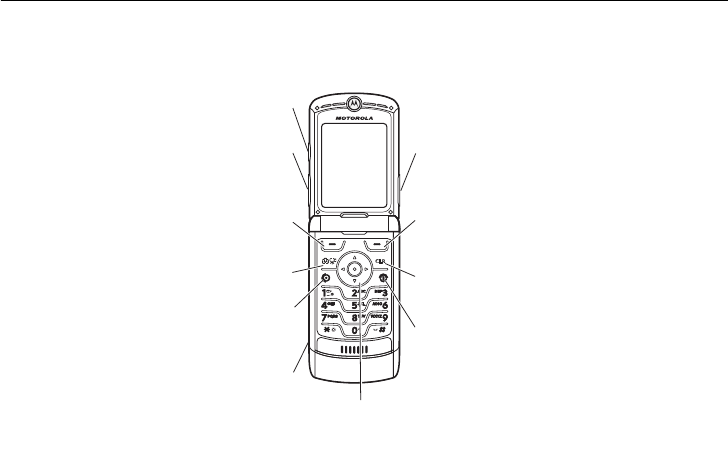
1
DRAFT
Welcome
We are pleased that you have chosen the Motorola K1c wireless phone.
040128o
Left Soft Key
Perform function
in lower left
display.
Voice Key
Create voice
records & voice
dial names.
Smart/
Speakerphone
Key
Volume Keys
Camera Key
4-Way Navigation Key
with Center Select
From home screen, press
center key to open main menu.
Clear Key
Right Soft Key
Perform function
in lower right
display.
Power & End Key
Turn phone
on/off, end calls,
exit menu
system.
Accessory
Connector Port
Insert charger &
phone
accessories.
Send Key
Make & answer
calls.
2
Motorola, Inc.
Consumer Advocacy Office
1307 East Algonquin Road
Schaumburg, IL 60196
www.hellomoto.com
1-800-331-6456 (United States)
1-888-390-6456 (TTY/TDD United States for hearing
impaired)
1-800-461-4575 (Canada)
Certain mobile phone features are dependent on the
capabilities and settings of your service provider’s
network. Additionally, certain features may not be
activated by your service provider, and/or the provider's
network settings may limit the feature’s functionality.
Always contact your service provider about feature
availability and functionality. All features, functionality,
and other product specifications, as well as the
information contained in this user's guide are based
upon the latest available information and are believed to
be accurate at the time of printing. Motorola reserves
the right to change or modify any information or
specifications without notice or obligation.
Caution:
Changes or modifications made in the
radio phone, not expressly approved by Motorola,
will void the user's authority to operate the
equipment.
MOTOROLA and the Stylized M Logo are registered in
the US Patent & Trademark Office. The Bluetooth
trademarks are owned by their proprietor and used by
Motorola, Inc. under license. All other product or service
names are the property of their respective owners.
© Motorola, Inc. 2006
Manual number: 6809

3
Contents
DRAFT
Contents
Use and Care
. . . . . . . . . 5
Getting Started
. . . . . . . . 6
About this Guide. . . . . . 6
Installing the Battery . . 7
Battery Tips . . . . . . . . . 7
Charging the Battery . . 8
Turning On Your
Phone . . . . . . . . . . . . . . 9
Adjusting Volume . . . . 10
Making a Call . . . . . . . 10
Answering a Call. . . . . 10
Changing the Call
Alert . . . . . . . . . . . . . . . 11
Viewing Your Phone
Number . . . . . . . . . . . . 11
Highlight Features
. . . . 12
Recording and Playing
Video Clips . . . . . . . . . 12
Taking and Sending a
Photo . . . . . . . . . . . . . 14
Sending a Multimedia
(Pix/Flix) Message . . . 16
Receiving a Multimedia
(Pix/Flix) Message . . . 18
Downloading
Pictures . . . . . . . . . . . 19
Downloading V CAST
Videos. . . . . . . . . . . . . 20
Bluetooth
Connections . . . . . . . . 20
Synchronize Data . . . . 22
TTY Operation . . . . . . 23
Learning to Use Your
Phone
. . . . . . . . . . . . . . 25
Using the Display . . . . 25
Using the 5-Way
Navigation Key . . . . . . 28
Using Menus . . . . . . . 28
Entering Text. . . . . . . . 30
Using the Handsfree
Speaker. . . . . . . . . . . . 36
Using the External
Display . . . . . . . . . . . . 37
Turning On Airplane
Mode . . . . . . . . . . . . . 37
Changing a Code, PIN,
or Password . . . . . . . . 38
Locking and Unlocking
Your Keypad . . . . . . . . 38
Locking and Unlocking
Your Phone . . . . . . . . . 39
If You Forget a Code,
PIN, or Password . . . . 39
4
Contents
DRAFT
Setting Up Your
Phone
. . . . . . . . . . . . . . 40
Ringer/Alert Styles and
Detailed Settings . . . . . 40
Activating Ringer IDs . . 41
Talking Phone
Settings . . . . . . . . . . . . 41
Setting Answer
Options . . . . . . . . . . . . 42
Setting a Wallpaper
Image . . . . . . . . . . . . . 42
Setting a Screen
Saver Image . . . . . . . . 43
Adjusting the
Backlight . . . . . . . . . . . 43
Hiding or Showing
Location Information . . 44
AGPS Limitations and
Tips . . . . . . . . . . . . . . . 44
Conserving Battery
Power . . . . . . . . . . . . . 45
Calling Features
. . . . . . 46
Changing the Active
Line . . . . . . . . . . . . . . . 46
Redialing a Number . . . 46
Using Automatic
Redial. . . . . . . . . . . . . . 46
Calling an Emergency
Number . . . . . . . . . . . . 47
Using AGPS During an
Emergency Call . . . . . . 47
Viewing Recent Calls. . 48
Returning an
Unanswered Call . . . . . 49
Attaching a Number. . . 50
Calling with Speed
Dial . . . . . . . . . . . . . . . 50
Calling with 1-Touch
Dial . . . . . . . . . . . . . . . 50
Using Voicemail . . . . . . 50
Phone Features
. . . . . . . 52
Main Menu . . . . . . . . . 52
Settings & Tools Menu
53
Messages . . . . . . . . . . 54
Contacts . . . . . . . . . . . 56
Personalizing Features. 59
Menu Features . . . . . . 62
Dialing Features . . . . . . 64
Call Monitoring . . . . . . 64
Handsfree Features . . . 65
Bluetooth Wireless
Connections . . . . . . . . 66
Data and Fax Calls . . . . 67
Network Features . . . . 68
Personal Organizer
Features. . . . . . . . . . . . 69
Security . . . . . . . . . . . . 70
News and
Entertainment . . . . . . . 70
Service & Repairs
. . . . 72
Specific Absorption Rate
Data
. . . . . . . . . . . . . . . 73
Index
. . . . . . . . . . . . . . 75

5
DRAFT
Use and Care
To care for your Motorola phone, please keep it away from:
liquids of any kind dust and dirt
Don’t expose your phone to
water, rain, extreme humidity,
sweat, or other moisture.
Don’t expose your phone to
dust, dirt, sand, food, or other
inappropriate materials.
extreme heat or cold cleaning solutions
Avoid temperatures below -
10°C/14°F or above 45°C/113°F.
To clean your phone, use only a
dry soft cloth. Don’t use alcohol
or other cleaning solutions.
microwaves the ground
Don’t try to dry your phone in a
microwave oven.
Don’t drop your phone.

6
Getting Started
DRAFT
Getting Started
About this Guide
This guide shows how to locate a menu
feature as follows:
Find it:
Press
MENU
(
s
)
ARECENT CALLS
Dialed
This example shows that from the home
screen, you must press
MENU
(
s
), scroll
across to
RECENT CALLS
on the main menu, then
scroll down to and select
Dialed
. Press
S
to
scroll across and down, and the center
key
s
to select a menu option.
CAUTION: Before using the phone for the
first time, read the
Important Safety and
Legal Information
included in the
gray-edged pages at the back of this guide.
032259o
symbols
This means a feature is network/
subscription dependent and may not
be available in all areas. Contact your
service provider for more
information.
This means a feature requires an
optional accessory.
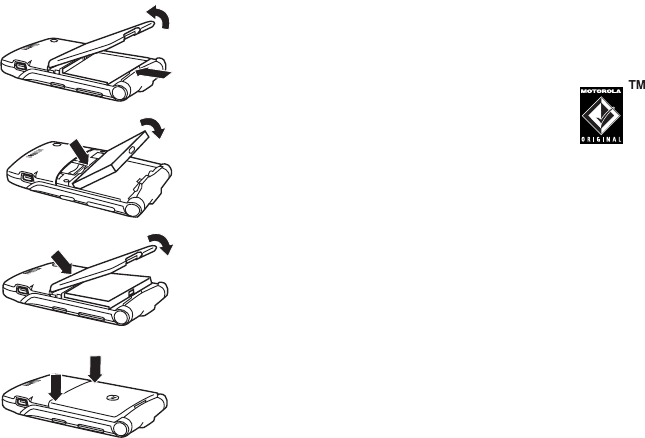
7
Getting Started
DRAFT
Installing the Battery Battery Tips
Battery life depends on the network, signal
strength, temperature, features, and
accessories you use.
•
Always use Motorola
Original batteries and
chargers. The warranty
does not cover damage
caused by non-Motorola batteries and/
or chargers.
•
New batteries or batteries stored for a
long time may take more time to
charge.
•
When charging your battery, keep it
near room temperature.
•
When storing your battery, keep it
uncharged in a cool, dark, dry place.
•
Never expose batteries to
temperatures below -10°C (14°F) or
1.
2.
3.
4.

8
Getting Started
DRAFT
above 45°C (113°F). Always take your
phone with you when you leave your
vehicle.
•
It is normal for batteries to gradually
wear down and require longer charging
times. If you notice a change in your
battery life, it is probably time to
purchase a new battery.
Contact your local recycling center for
proper battery disposal.
Warning:
Never dispose of batteries in a fire
because they may explode.
Before using your phone, read the battery
safety information in the “Safety and General
Information” section included in this guide.
Charging the Battery
New batteries are shipped partially charged.
Before you can use your phone, you need to
install and charge the battery as described
below. Some batteries perform best after
several full charge/discharge cycles.
Using the Charger
1
Insert the
charger into the
USB connector
on your phone
as shown.
2
Plug the other
end of the
charger into the appropriate electrical
outlet.
3
When your phone indicates
Charge Complete
,
remove the charger.
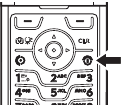
9
Getting Started
DRAFT
Tip:
You can safely leave the charger
connected to the phone after charging is
complete. This will
not
damage the battery.
When you charge the battery, the battery level
indicator in the upper right corner of the
display shows how much of the charging
process is complete. At least 1 segment of
the battery level indicator must be visible to
ensure full phone functionality while charging.
Charging from a Computer
You can charge your battery by connecting a
cable from your phone's mini-USB port to a
high-power USB port on a computer (not a
low-power one such as the USB port on your
keyboard or bus-powered USB hub). Typically,
USB high-power ports are located directly on
your computer.
Both your phone and the computer must be
turned on, and your computer must have the
correct software drivers installed. Cables and
software drivers are available in
MotorolaOriginal data kits, sold separately.
Turning On Your Phone
1
Open your phone.
2
Press and hold the
power key for 3
seconds.
The phone may
require several
seconds to power on.
3
If necessary, enter your 4-digit unlock
code (the last 4 digits of your phone
number) and press
OK
to unlock the
phone.
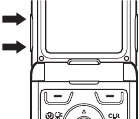
10
Getting Started
DRAFT
Adjusting
Volume
Press the up or down
volume keys to:
•
increase or decrease earpiece volume
during a call
•
increase or decrease ringer volume
setting when the home screen is
visible (phone must not be in a call and
flip must be open)
•
silence an incoming call alert
Making a Call
1
Dial the number.
Tip:
If you make a mistake, press the
clear key
B
to delete the last digit. Press
and hold
B
to clear all digits.
2
Press
N
to make the call.
3
Press
P
to end the call.
Tip:
Closing the flip also ends the call unless
you are using the speakerphone feature (see
page 36).
Note:
You must dial the phone number from
the home screen. See page 25.
Answering a Call
When you receive a call, your phone rings
and/or vibrates and displays an incoming call
message.
1
Press
N
to answer.
2
Press
P
to end the call.
Tip:
You can set the phone to answer calls
when you open the flip. (To activate, press
MENU
(
s
)
DSETTINGS & TOOLS
Call Settings
In-Call Setup
Answer Options
Open To Answer
.)
040135o
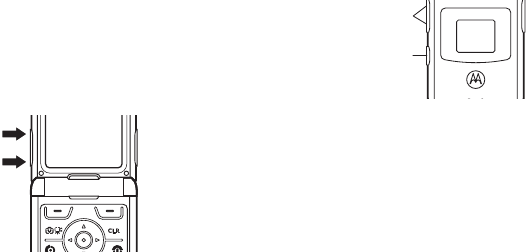
11
Getting Started
DRAFT
Note:
If the phone is locked, you must first
enter your 4-digit unlock code to answer the
call.
Changing the Call Alert
Phone Flip
Open
In the home screen,
press the down volume
key to switch to lower
call alert volume, then
switch to
Vibrate
, then
Alarm
, and, finally,
All Off
.
Press the up volume key to cycle back from
silent alert to vibrate and then to the lowest
alert volume setting.
Phone Flip Closed
Press the up or
down volume
key, then press
the smart/
speakerphone
key to scroll through the alert styles:
Master
Volume
,
Alarm Only
,
Vibrate Only
, and
All Off
. The alert
styles are shown on the external display.
After scrolling to the desired alert style, press
the up or down volume key to save the setting
and return to the home screen.
Viewing Your Phone
Number
To view your phone number from the home
screen, press
B#
.
While you are on a call, press
Options
, then
select
My Tel. Numbers
.
040135o
Volume Keys
Smart/
Speakerphone
Key
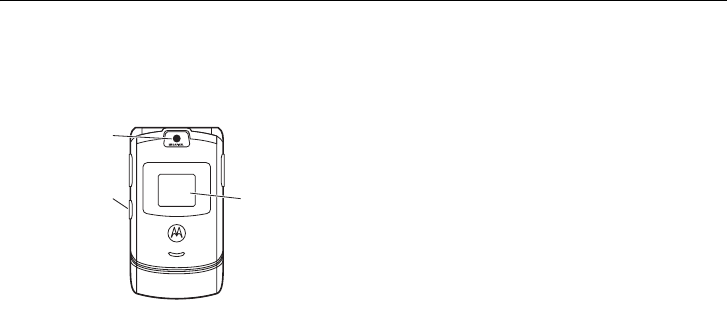
12
Highlight Features
DRAFT
Highlight Features
You can do much more with your phone than
make and receive calls! This section
describes some of your phone’s highlights.
Recording and Playing
Video Clips
You can record a video clip with your phone
and send it to other wireless phone users in a
multimedia message.
Record a Video Clip
To activate your phone’s video camera:
1
Press
S
left to open the
GET PIX & FLIX
menu.
2
Scroll to
Take FLIX
and press
OK
(
s
).
Tip:
You can also activate the video
camera viewfinder by pressing and
holding the camera key
b
.
Camera Lens
Smart/
Speakerphone
Key
Take self-portrait
photo with
camera when flip
is closed.
External Display
View incoming
call information,
use as camera
viewfinder when
flip is closed.
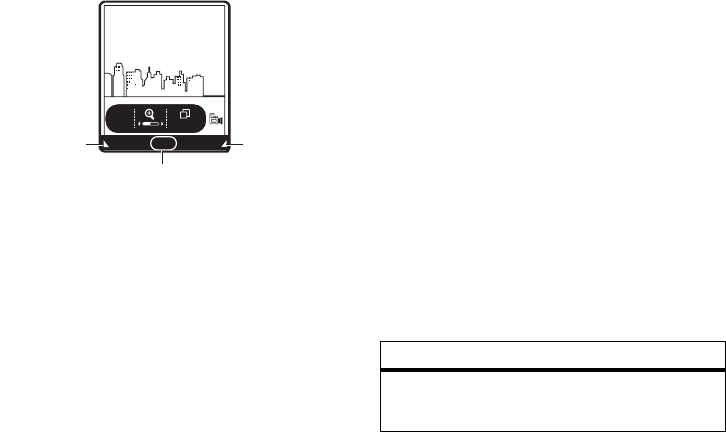
13
Highlight Features
DRAFT
The active viewfinder image appears on
your display.
3
Point the camera lens at the video
subject.
Press
S
left and right to zoom in and out.
Press
Options
to open the
OPTIONS
menu (see
“Adjust Video Recording Settings” on
page 13).
4
Press
REC
(
s
) to begin recording.
Press
Pause
to temporarily stop recording,
then press
Resume
to continue.
5
Press
Stop
(
s
) to stop recording.
6
Press
Save
to save the video.
or
Press
SEND
(
s
) to save the video and go
to the
CREATE PIX MESSAGE
screen.
or
Press
Erase
to delete the video and return
to active viewfinder.
Adjust Video Recording
Settings
When the video camera is active, press
Options
to open the
OPTIONS
menu, which can include
the following options:
ß
480x640
Press right soft
key to view
Options
menu.
Press left soft
key to view
My FLIX.
Press s to
begin
recording.
My FLIX Options
REC
N
Option
Brightness
Adjust image brightness.

14
Highlight Features
DRAFT
Play a Video Clip
To play a video clip stored on your phone:
1
Press
S
left to open the
GET PIX & FLIX
menu.
2
Scroll to
My FLIX
and press
OK
(
s
).
3
Scroll to the clip you want to view and
press
PLAY
(
s
).
Press
Mute
while the video clip is playing to
mute the video clip sound. Press
Mute
again to turn sound on again.
Taking and Sending a
Photo
You can take a photo with your phone, and
send it to other wireless phone users in a
multimedia message.
Take and Send a Photo
To activate your phone’s camera:
1
Press
S
left to open the
GET PIX & FLIX
menu.
2
Scroll to
Take PIX
and press
OK
(
s
).
Tip:
You can also activate the camera
viewfinder by pressing the camera
key
b
.
White Balance
Adjust for different lighting.
Duration
Specify standard lengths of video clips of 5,
10, or 15 seconds.
Color Effects
Select
Normal
,
Sepia
,
Black & White
, or
Negative
.
Option
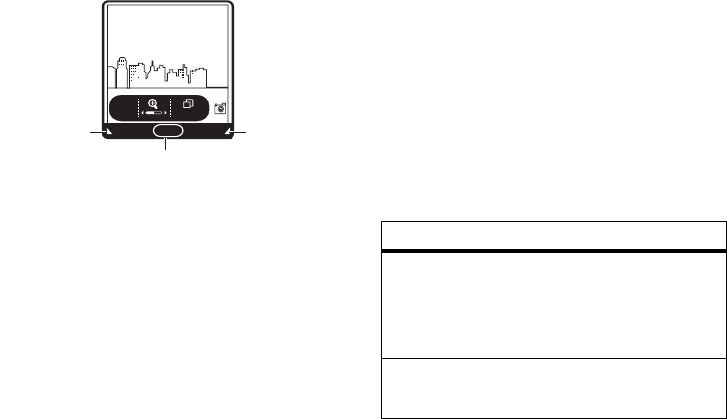
15
Highlight Features
DRAFT
The active viewfinder image appears on
your phone’s display.
3
Point the camera lens at the photo
subject, then press
TAKE
(
s
) to take a
photo.
Press
S
left and right to zoom in and out.
Press
Options
to open the
OPTIONS
menu (see
“Adjust Camera Settings” on page 15).
4
Press
Save
to save the photo.
or
Press
SEND
(
s
) to save the photo and go
to the
Create Pix Msg
screen.
or
Press
Erase
to delete the photo and return
to active viewfinder.
Adjust Camera Settings
When the camera is active, press
Options
to
open the
OPTIONS
menu, which can include the
following options:
ß
480x640
Press right soft
key to view
Options
menu.
Press left soft
key to view
My PIX.
Press s to
Take
photo.
My PIX Options
TAKE
N
Option
Resolution
Set resolution to
High (1280x1024)
,
Medium (640x480)
,
Low (320x240)
, or
Thumbnail (160x120)
.
Self timer
Set a timer for the camera to take a photo.
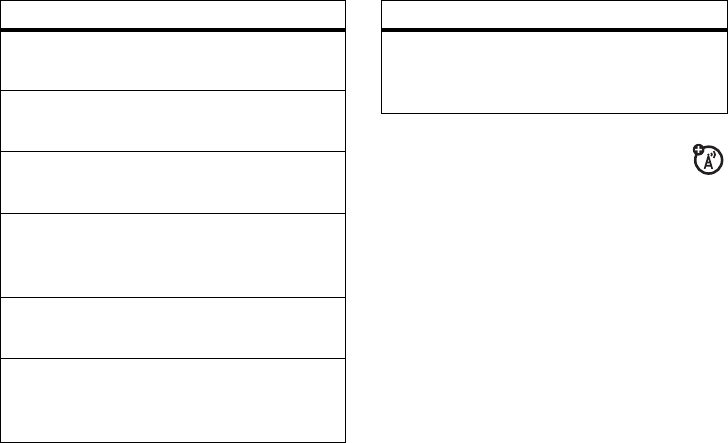
16
Highlight Features
DRAFT
Sending a
Multimedia (Pix/Flix)
Message
A multimedia message contains embedded
media objects (possibly including photos,
pictures, animations, sounds, voice records).
You can send a multimedia message to other
Verizon Wireless multimedia messaging-
capable phones and to other email addresses.
Create and Send Message
Find it:
Press
MENU
(
s
)
CMESSAGING
New Pix Msg
Brightness
Adjust image brightness.
White Balance
Adjust for different lighting.
Image Quality
Select
Fine
,
Normal
, or
Economy
.
Shutter Sound
Activate a tone that plays when you take a
photo.
Color Effects
Select
Normal
,
Sepia
,
Black & White
, or
Negative
.
Multishot
Set the camera to take multiple photos with
a single press of the camera key
b
.
Option
Fun Frame
Go to
Fun Frames
to select an amusing frame
for your photo.
Option
17
Highlight Features
DRAFT
1
Press keypad keys, then
OK
(
s
), to enter
a phone number.
or
Press
Add
Contacts
, then
OK
(
s
). For each
Contacts
entry you want to add, highlight the
entry and press
OK
(
s
). Press
Done
when
finished adding
Contacts
entries.
or
Press
Add
Recent Calls
, then
OK
(
s
). For
each call you want to add, highlight the
entry and press
OK
(
s
). Press
Done
when
finished adding entries from
Recent Calls
.
2
Scroll to the
Text
entry box.
3
Press keypad keys to enter message text.
4
Scroll to the
Pix or Flix
entry box and press
Gallery
.
5
Scroll to
Pix Gallery
(for pictures) or
Flix Gallery
(for video clips) and press
OK
(
s
).
6
Scroll to and highlight a picture or video
clip to insert, and press
OK
(
s
).
7
Scroll to the
Sound
entry box and press
Sounds
.
8
Scroll to and highlight a sound to insert,
and press
OK
(
s
).
9
Scroll to
Subject
.
10
Press keypad keys, then
OK
(
s
), to enter
the message subject.
or
Press
Options
, scroll to
Add Quick Text
, then
press
OK
(
s
), to select a
Quick Text
item as
the message subject.
11
Press
SEND
(
s
) to send the message.
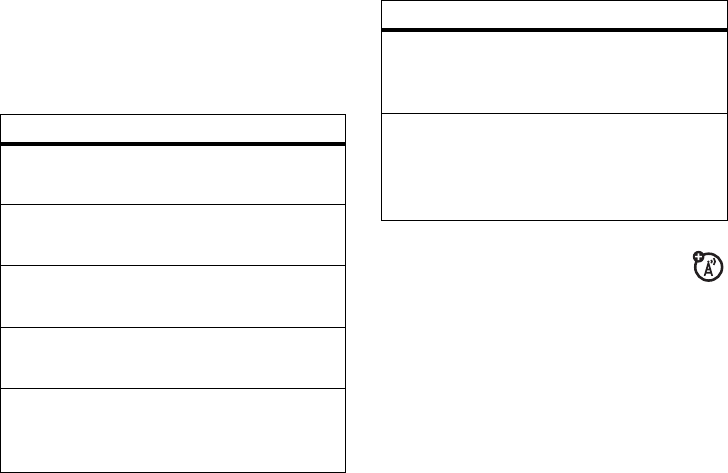
18
Highlight Features
DRAFT
Message Options
While creating a multimedia message, press
Options
to open the
CREATE PIX MESSAGE
menu,
which can include the following options:
Receiving a
Multimedia (Pix/Flix)
Message
When you receive a multimedia message,
your phone displays the
g
(message waiting)
indicator and a
New Message
notification, and
sounds an alert.
Option
Entry Mode
Select a text entry mode (see page 31).
Preview
View the current contents of the message.
Save As Draft
Save the message to the
Drafts
folder.
Priority Level
Set to
High
or
Normal
.
Validity Period
Specify the length of time the message
remains in the
Outbox
folder.
Deferred Delivery
Send the message later, at a time and date
that you specify.
Remove Picture, Remove Video, Remove Sound, Remove
VCard
Remove a multimedia object from the
message.
Option

19
Highlight Features
DRAFT
Open the flip and press
READ
to view the
message immediately or to save it in your
Inbox
for viewing later.
To view messages in your
Inbox
:
Find it:
Press
MENU
(
s
)
CMESSAGING
Inbox
1
Scroll to the desired message.
2
Press
Open
to open the message. Your
phone first displays the picture, then the
message.
Multimedia messages that you receive can
contain different media objects:
•
Photos, pictures, and animations are
displayed as you read the message.
•
A sound file begins playing when its
slide is displayed. Use the volume keys
to adjust the volume as the sound file
plays.
•
Attached files are appended to the
message. To open the attachment,
highlight the file indicator/filename and
press
VIEW
(image file type),
PLAY
(sound
file), or
OPEN
(vObject such as a
Contacts
or datebook entry, or unknown file
type).
Downloading
Pictures
1
Press
S
left to open
GET PIX & FLIX
.
2
Scroll to
Get New PIX
and press
OK
(
s
).
3
With
Get New
highlighted, press
OK
(
s
) to
connect to
Get It Now
.
Note:
Normal airtime and/or carrier usage
charges apply.

20
Highlight Features
DRAFT
Downloading
V CAST Videos
1
Press
S
left to open
GET PIX & FLIX
.
2
Scroll to
Get V CAST Video
and press
OK
(
s
).
Normal airtime and/or carrier usage charges
apply.
Bluetooth Connections
Your phone supports Bluetooth
®
connections.
You can connect your phone to a Bluetooth
headset or car kit, or connect to another
device to exchange and synchronize files.
Your phone currently supports the following
Bluetooth profiles:
•
headset (optional Motorola Original™
accessory)
•
Handsfree Car Kit (optional Motorola
Original accessory)
For more information about Bluetooth
wireless connections supported by this
device, go to FAQs
www.verizonwireless.com/bluetooth
.
For information on vehicle compatibility, go to
www.verizonwireless.com/bluetoothchart
to view the Bluetooth compatibility chart.
Note:
All multimedia (video player, audio
player, shutter tones, V CAST) will play from
the speakerphone when your phone is
connected to another Bluetooth device.
For maximum Bluetooth security,
you
should always pair Bluetooth devices in a
safe, private environment.

21
Highlight Features
DRAFT
Turn Bluetooth Power On or
Off
Find it:
Press
MENU
(
s
)
DSETTINGS & TOOLS
Connections
Bluetooth
Setup
Power
On
Note:
To extend battery life, use the above
procedure and set Bluetooth power to
Off
when not in use. If you turn Bluetooth power
Off
, your phone will not connect to accessories
until you turn Bluetooth power
On
and
reconnect to the accessories.
Pairing with a Headset,
Handsfree Device, or PC
Before you try to connect to another
Bluetooth device,
make sure your phone’s
Bluetooth power is
On
and the device is in
pairing mode (see the user guide for the
device you are attempting to pair with). You
cannot perform pairing while your phone is
connected to another device.
To pair your phone to a headset accessory,
handsfree car kit, or PC that supports
Bluetooth wireless connections:
Find it:
Press
MENU
(
s
)
DSETTINGS & TOOLS
Connections
Bluetooth
Handsfree
[Look For Devices]
Your phone displays a list of device(s) located
within range of the phone. If your phone is
already connected to a device, your phone
lists that device and identifies it with a
\
(in-
use indicator). Once a connection is
established with a device, no other device can
connect to your phone until the currently
connected device is disconnected.
1
Highlight a device in the list of devices
your phone found.
2
Press
Select
to connect the device.
3
If the device requests permission to bond
with your phone, select
YES
and enter the

22
Highlight Features
DRAFT
device PIN code to create a secure
connection with the device.
Note:
The default PIN code is 0000.
When the connection is made, the
à
(Bluetooth) indicator or a
Bluetooth
message
displays in the home screen.
Tip:
For specific information about an
accessory, refer to the instructions that came
with it.
Synchronize Data
Use a Bluetooth wireless connection or
a USB cable connection to transfer and
synchronize data between your phone and a
PC.
Make sure that you connect your phone to a
high-power USB port on your computer (not a
low-power one such as the USB port on your
keyboard or bus-powered USB hub). Typically,
USB high-power ports are located directly on
your computer.
Note:
If you connect your phone to a low-
power USB port on your computer, the
computer may not recognize your phone.
To transfer data between your phone and PC:
•
You must use the cables and install the
Motorola Mobile PhoneTools software
included with the Motorola Original™
data kit (see the data kit user’s guide
for more information).
•
Make sure both your phone and the
computer are turned on.
Motorola Mobile PhoneTools software is
designed to synchronize with basic features
of many popular Personal Information
Management (PIM) software and hardware
products. Use Motorola Mobile PhoneTools
software to synchronize data between your
phone and PC.

23
Highlight Features
DRAFT
To synchronize data between your phone and
PC, select the
Sync
option from the Motorola
Mobile PhoneTools software running on the
PC. See the Mobile PhoneTools user’s guide
for more information.
TTY Operation
You can use an optional TTY device with your
phone to send and receive calls. You must
plug the TTY device into the phone’s headset
jack and set the phone to operate in 1 of 3
TTY modes.
Note:
Use a TSB-121 compliant cable
(provided by the TTY manufacturer) to
connect the TTY device to your phone.
Note:
Set the phone to level 4 (middle setting)
for proper operation. If you experience a high
number of incorrect characters, adjust the
volume as needed to minimize the error rate.
Note:
For optimal performance, your phone
should be at least 12 inches (30 centimeters)
from the TTY device. Placing the phone too
close to the TTY device may cause high error
rates.
Setting TTY Mode
ù
When you set your phone to a TTY mode,
it operates in that mode whenever the TTY
device is connected.
Find it:
Press
MENU
(
s
)
DSETTINGS & TOOLS
Initial Setup
TTY Setup
TTY Mode
can include the following options:
Option
Voice
Return to standard voice mode.
TTY
Transmit and receive TTY characters.

24
Highlight Features
DRAFT
When your phone is in a TTY mode, the
international TTY mode, the international TTY
symbol, and the mode setting display during
an active TTY call.
Returning to Voice Mode
To return to standard voice mode, select
Voice
from the
TTY Setup
menu.
VCO
Receive TTY characters but transmit by
speaking into microphone.
HCO
Transmit TTY characters but receive by
listening to earpiece.
Option
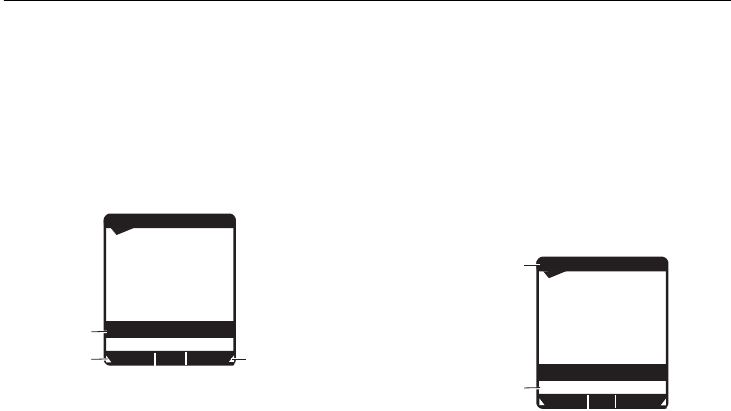
25
Learning to Use Your Phone
DRAFT
Learning to Use Your Phone
See page 1 for a basic phone diagram.
Using the Display
The home screen is displayed when you are
not
on a call or using the menu. You must be
in the home screen to dial a phone number.
Note:
Your home screen may look different
than the display shown above.
The
MENU
label in the bottom center of the
display shows that you can press the center
key
s
to enter the main menu.
Labels at the bottom corners of the display
show the current soft key functions. Press the
left or right soft key to perform the function
indicated by the left or right soft key label.
Your phone displays indicators in 2 areas:
678eghu5wr4
1N
Right Soft Key
Label
Date & Time
Left Soft Key
Label
Message Contacts
MENU
Thu, Oct 23 12:45pm
B
e
W
L
678eghu5wr4
N
1
System Status
Indicators
Service Alerts &
Settings
Indicators
Message Contacts
MENU
Thu, Oct 23 12:45pm
B
e
W
L
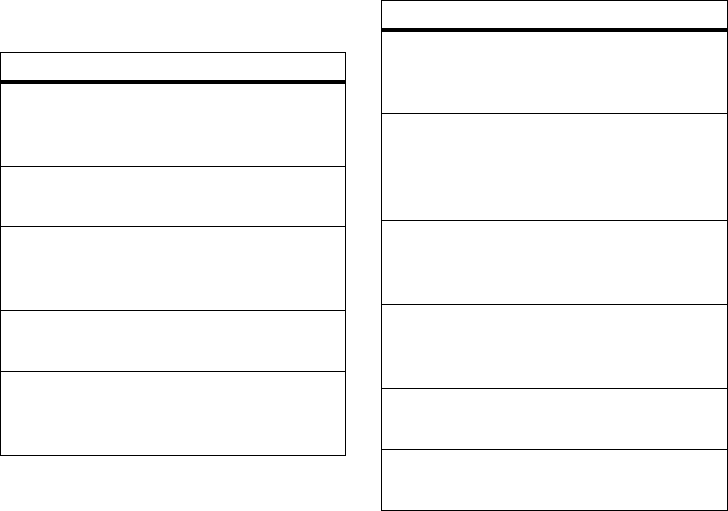
26
Learning to Use Your Phone
DRAFT
The following table describes the indicators
your phone can display:
Alert/Indicator
1
Signal Strength Indicator
Vertical bars show the strength of the
network connection.
2
Roaming Indicator
Indicates phone is in digital coverage area.
7
1x-EVDO Indicator
Indicates phone is in 1x-EVDO coverage
area (necessary for V CAST services).
I
1X Indicator
Indicates phone is in 1x-RTT coverage area.
5
SSL Indicator
Indicates
application verification is via
SSL during a download session.
6
Voice Privacy Indicator
Indicates
Voice Privacy
is set to
On
and is
enabled during active call.
L
Data Call, Tethered, or Embedded
WAP/BREW Application Indicator
S
hows during data call, tethered mode, or
WAP/BREW application.
M
Dormant
Indicates
phone is dormant and PPP
session is active.
9
No Service Indicator
P
hone is in area with no service
coverage.
8
TTY Indicator
P
hone is in TTY mode.
t
Voice Call Indicator
S
hows during an active voice call.
Alert/Indicator
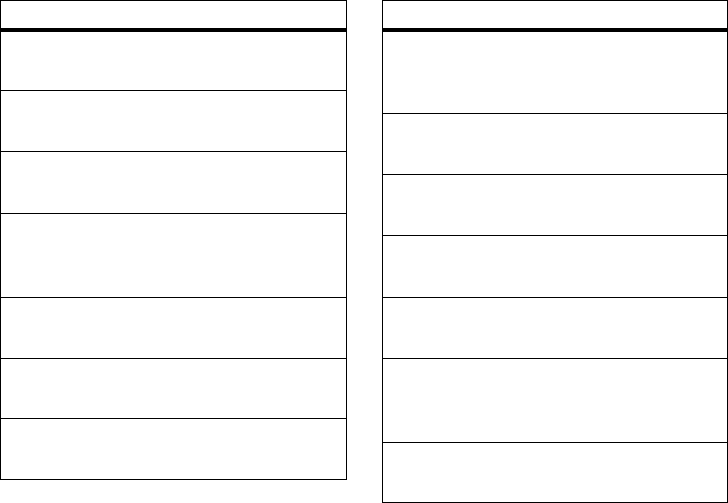
27
Learning to Use Your Phone
DRAFT
P
E911 Indicator
Indicates
E911
is set to
On
.
O
Location On Indicator
Indicates
Location
is set to
On
.
0
Keypad Lock Indicator
Indicates
keypad lock is set to
On
.
N
Battery Level Indicator
S
hows battery charge level. The more
bars, the greater the charge.
n
All Sounds Off
Indicates
Master Volume
is set to
Off
.
o
Alarm Only
Indicates
Master Volume
is set to
Alarm Only
.
r
Vibrate On
Indicates
Master Volume
is set to
Vibrate On
.
Alert/Indicator
p
Sound On, Vibrate On
Indicates
Master Volume
is set to
Sound On
and
Vibrate On
.
q
Speakerphone
Indicates
speakerphone is on.
s
Missed Call
Indicates a
missed call.
g
Message Indicator
S
hows when you receive a new message.
x
Calendar Appointment
Sh
ows number of calendar appointments.
y
Voicemail
S
hows number of voicemail messages
received.
u
Alarm On
S
hows when an alarm has been set.
Alert/Indicator
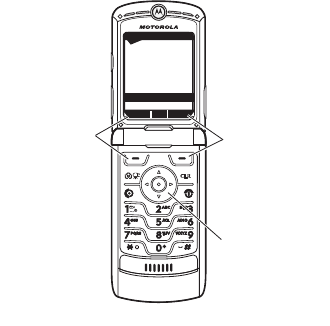
28
Learning to Use Your Phone
DRAFT
Using the 5-Way
Navigation Key
Use the 5-way navigation key (
S
) to scroll
up, down, left, or right through the menu
system. Press the center key
s
select a
highlighted menu item.
Using Menus
From the home screen, press
MENU
(
s
) to
enter the main menu.
The following icons represent features that
may appear in the main menu, depending on
040128o
Left Soft Key
Perform left
function.
5-Way
Navigation Key
Scroll through
menus & lists.
From home
screen, press
center key to
open main
menu.
Right Soft Key
Perform right
function.
1
N
Message Contacts
MENU
Thu, Oct 23 12:45pm
B
e
L
W
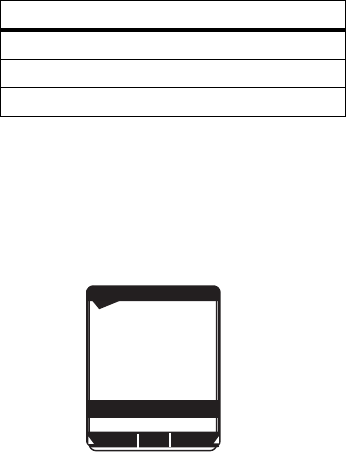
29
Learning to Use Your Phone
DRAFT
your service provider and service subscription
options.
Menu Shortcuts
Your phone displays 4 menu icons in the
middle of the home screen.
Press
S
left, right, up, or down to open the
menu represented by the icon you select. You
can change the menu icons that appear in the
home screen, or set your phone not to display
icons in the home screen (see “Show or Hide
Menu Icons” on page 62).
Tip:
From the main menu, you can quickly
select a menu feature by pressing the number
key associated with that feature. For example,
from the
SETTINGS & TOOLS
menu, press
4
to
select
Display
.
Select a Feature Option
When you select certain features, your phone
displays a list of items or options that you can
select. For example, when you view the
Menu Features
BGET IT NOW* CMESSAGING
ECONTACTS ARECENT CALLS
DSETTINGS & TOOLS
* Optional network/subscription
dependent feature
040128o
1
N
Message Contacts
MENU
Thu, Oct 23 12:45pm
B
e
L
W
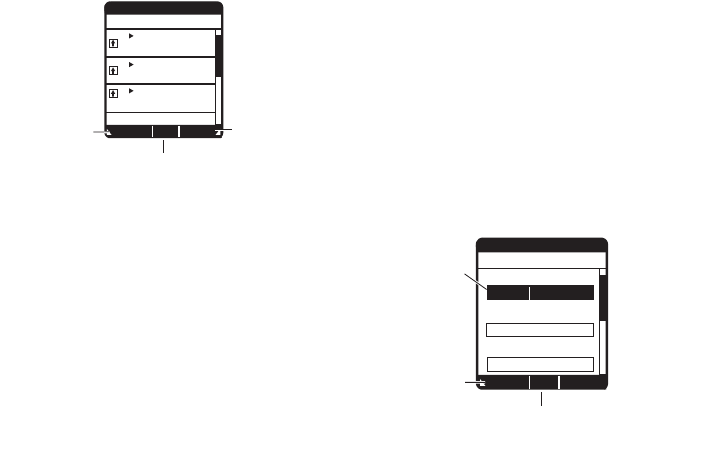
30
Learning to Use Your Phone
DRAFT
dialed calls list, you can select an entry and
perform additional tasks on that entry:
•
Press
S
to scroll up or down to
highlight the option you want.
•
In a numbered list, press a number key
to highlight the option.
•
In an alphabetized list, press a key
repeatedly to cycle through the letters
on the key and highlight the closest
matching list option
•
When an option has a list of possible
values, press
S
left or right to scroll
through and select a value.
•
When an option has a list of possible
numeric values, press a number key to
set the value.
Entering Text
Some features require you to enter
information. The following is a sample of a
screen for
Contacts
entry information.
1N
Press right soft
key to open
Options
sub-menu.
Press s to open
item to view item
details.
Press left soft key
to open
Messaging
menu.
Message Options
OPEN
DIALED CALLS
Jonathan
Tue Jul 19, 4:43pm
212-345-4566
Mon Jul 18, 3:08pm
Mindy
Mon Jul 18, 10:46am
v
t
x
1N
Press S to
scroll to more
options.
Press s to save
entry information.
Press left soft
key to change
entry mode.
Highlighted
Option
Abc SAVE
EDIT CONTACT
Name
John Smi
Mobile 1
Home
v
x
Abc
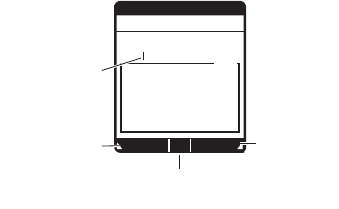
31
Learning to Use Your Phone
DRAFT
The message center lets you compose and
send text messages.
Choose a Text Entry Mode
Multiple text entry mode make it easy for you
to enter names, numbers, and messages. The
mode you select remains active until you
select another mode.
From the
CREATE TXT MESSAGE
screen press
Options
, then select
Entry Mode
to select an entry
mode. From the
EDIT CONTACT
screen, press
Abc
to select an entry mode.
You can select 1 of the following entry
modes:
1 N
1.
2.
3.
4.
Press right
soft key to
view
Options
sub-menu.
Press s to send
message.
Press left soft
key to view
Add
sub-menu.
Flashing cursor
indicates
insertion point.
Add Options
OK
CREATE TXT MESSAGE
1/7 0/160
To: 123
iTAP
English
Let the phone predict each word
(in English) as you press keys.
iTAP
Spanish
Let the phone predict each word
(in Spanish) as you press keys.
Abc
Enter letters and numbers by
pressing a key 1 or more times,
1st character in uppercase.
ABC
Enter letters and numbers by
pressing a key 1 or more times,
all characters in uppercase.
123
Enter numbers only.
Symbols
Enter symbols.
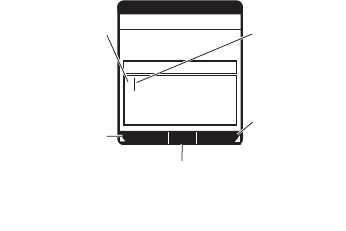
32
Learning to Use Your Phone
DRAFT
Capitalization and Numbers
Press
*
in any text entry screen to cycle
through entry methods:
Tap Mo d e
From a text entry screen, specify Tap mode by
pressing
Abc
, then selecting
Abc
or
ABC
.
This is the standard method for entering text
on your phone. Regular Tap mode cycles
through the letters and numbers of the key
you press, as shown in the “Character Chart”
on page 33.
1
Press a keypad key 1 or more times to
select a letter, number, or symbol.
2
Enter the remaining characters.
Tip:
Press
S
right to accept a word
completion, or
#
to insert a space.
3
Press
OK
to store the text.
When you enter text with Tap mode, the soft
key functions change.
abc
= no capital
letters
123
= all numbers
ABC
= all capital
letters
Abc
= capitalize
next letter only
iTAP
= predictive text
entry
1 N
After 2 seconds,
character is
accepted &
cursor moves to
next position.
Character
displays at
insertion point.
Abc Options
SEND
CREATE TXT MESSAGE
To:
T
Press left soft key
to add message
recipients from
Contacts or Recent
Calls lists, or
add multimedia
objects or
Quick Text.
Press right
soft key to open
Options menu.
Press s to send
message.
1/7 0/160
233-2233
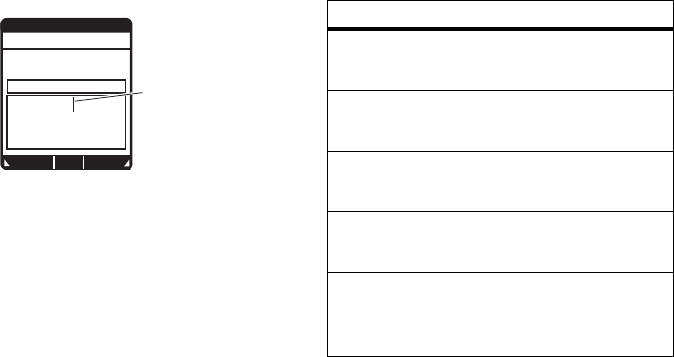
33
Learning to Use Your Phone
DRAFT
When you enter 3 or more characters in a
row, your phone may guess the rest of the
word. For example, if you enter
prog
, you might
see:
If you want a different word (such as
progress
),
continue pressing keypad keys to enter the
remaining characters.
Character Chart
Use this chart as a guide for entering
characters with Tap mode
.
1
N
Press S up
to accept
program
.
Enter a space
after
prog
to keep
only prog.
Abc Options
SEND
CREATE TXT MESSAGE
To:
This is a prog ram
1/7 0/160
233-2233
Keys/Characters
1
. @ ? ! - , & : _ / ; 1
2
a b c 2
3
d e f 3
4
g h i 4
5
j k l 5
6
m n o 6
7
p q r s 7
8
t u v 8
9
w x y z 9
0
change text case, for
capital letters

34
Learning to Use Your Phone
DRAFT
Note:
This chart shows lowercase letters,
which are produced in ABC mode. Select ABC
mode to produce the capitalized versions of
the letters shown.
Note:
This chart may not reflect the exact
character set available on your phone. In a
URL editor,
1
first shows common
characters for that editor.
Tap Mode Text Entry Rules
•
Press a keypad key repeatedly to cycle
through its characters.
•
Press
S
left or right to move the
flashing cursor to the left or right in a
text message.
•
The first character of every sentence is
capitalized. If necessary, press
S
down to force the character to
lowercase before the cursor moves to
the next position.
•
If you enter or edit information and do
not want to save the changes, press
P
to exit without saving.
iTAP
®
Mode
From a text entry screen, specify iTAP mode
by pressing
Abc
, then selecting
iTAP English
or
iTAP Spanish
.
iTAP software provides a predictive text entry
method that lets you enter a word using 1 key
press per letter. This can be faster than Tap
*
change text entry
method (hold for
default)
#
enter space
Keys/Characters
35
Learning to Use Your Phone
DRAFT
mode, because your phone combines the key
presses into common words.
For example, if you press
7
7
6
4
, you
see the letters
Program
. If you want a different
word (such as
Progress
), continue pressing
keypad keys to enter the remaining
characters.
Entering Words
1
Press keypad keys (1 press per letter) to
begin entering a word. As you type, your
phone automatically shows additional
letters that form a suggested
combination.
2
Scroll right to view other possible
combinations, and highlight the
combination you want.
3
Press
S
up to enter the highlighted
combination when it spells a word. A
space is automatically inserted after the
word.
If you enter a word your phone does not
recognize, the phone stores it to use as 1 of
your word options. When you fill memory
space for unrecognized words, your phone
deletes the oldest words to add new words.
Numeric Mode
From a text entry screen, specify Numeric
mode by pressing
Abc
, then selecting
123
.
Press keypad keys to enter the numbers you
want. When you finish entering numbers,
press
*
to switch to another entry method.
Symbol Mode
From a text entry screen, specify Symbols
mode by pressing
Abc
, then selecting
Symbols
.
Scroll to the desired symbol on the
SYMBOLS
screen, then press
OK
(
s
) to select it.
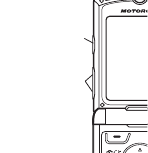
36
Learning to Use Your Phone
DRAFT
Press
Next
on the
SYMBOLS
screen to page
down to the next set of symbols, and press
Prev
to page up to the previous set.
Delete Letters and Words
Place the cursor to the right of the text you
want to delete, and then:
•
Press
B
to delete 1 letter at a time.
•
Hold
B
to delete the entire message.
Using the Handsfree
Speaker
Note:
You must open your phone’s flip to
activate the speakerphone.
Your phone’s integrated handsfree speaker
allows you to talk to another party without
holding the phone to your ear.
Turn Handsfree
Speaker On/Off
To activate the
speakerphone
during a
call, press and hold the
smart/speakerphone
key.
Your will see
Spkrphone On
, and the
speakerphone indicator
q
, and hear a soft
audio alert.
To end the call
, press
End Call
or press
P
. You
will see
Call Ended
and hear a soft audio alert.
Note:
Closing the flip while using the
speakerphone does not end the call.
The speakerphone remains on until you press
the smart/speakerphone key again or turn off
the phone.
04012
Volume Keys
Smart/
Speakerphone
Key
37
Learning to Use Your Phone
DRAFT
You can also set your phone to turn off the
speakerphone automatically after 20 seconds
of inactivity:
Find it:
Press
MENU
(
s
)
DSETTINGS & TOOLS
Initial Setup
SpeakerPhone
20 sec timeout
Note:
The handsfree speaker is disabled
when you connect your phone to a handsfree
car kit or headset accessory.
Use Handsfree Speaker with
Flip Closed
1
Open your phone’s flip.
2
Press and hold the smart/speakerphone
key to turn on the speakerphone.
3
Enter the number you wish to call and
press
N
.
4
When the call is connected, close the flip,
and continue your conversation.
5
To end the call, press and hold the smart/
speakerphone key. You will see
Call Ended
and hear a soft audio alert.
Using the External
Display
When the flip is closed, you can use the
external display for the following:
•
View time, date, and phone status
information.
•
View message notifications.
Turning On Airplane
Mode
Note:
Consult airline staff about the use of
Airplane Mode
in flight. Turn off your phone
whenever instructed to do so by airline staff.
38
Learning to Use Your Phone
DRAFT
Airplane Mode
allows you to disable your phone’s
radio frequency functions and still use other
applications (such as the calculator or
datebook functions). This may enable you to
use these applications while on an airplane.
Find it:
Press
MENU
(
s
)
DSETTINGS & TOOLS
Airplane Mode
Changing a Code, PIN,
or Password
Your phone’s 4-digit unlock code is originally
set to the last 4 digits of your phone number,
and the 6-digit security code is originally set to
000000. Your service provider may reset
these codes before you receive your phone.
If your service provider has
not
reset these
codes, we recommend that you change them
to prevent others from accessing your
personal information. The unlock code must
contain 4 digits, and the security code must
contain 6 digits.
To change a code or password:
Find it:
Press
MENU
(
s
)
DSETTINGS & TOOLS
System
Security
New Passwords
Select the type of code you wish to change,
enter the old code when prompted, then
enter the new code.
Locking and Unlocking
Your Keypad
You can lock your phone’s keypad to prevent
accidental key presses.
Press
B
*
to lock/unlock the keypad.
39
Learning to Use Your Phone
DRAFT
Locking and Unlocking
Your Phone
You can lock your phone manually or set the
phone to lock automatically whenever you
turn it off.
To use a locked phone, you must enter the
unlock code. A locked phone still rings or
vibrates for incoming calls or messages,
but
you must unlock it to answer
.
You can make emergency calls on your phone
even when it is locked (see page 47).
Lock Your Phone
Find it:
Press
MENU
(
s
)
DSETTINGS & TOOLS
System
Security
Phone Lock
Lock Now
or
Automatic Lock
Both
Phone Lock
options require you to enter the
unlock code before completing your selection.
Unlock Your Phone
At the
Enter Unlock Code
prompt, enter your
unlock code and press
OK
(
s
) to unlock your
phone.
If You Forget a Code,
PIN, or Password
Note:
Your phone’s 4-digit unlock code is
originally set to the last 4 digits of your phone
number, and the 6-digit security code is
originally set to 000000.
If you forget your security code, contact your
service provider.

40
Setting Up Your Phone
DRAFT
Setting Up Your Phone
Ringer/Alert Styles and
Detailed Settings
Use
Ring Styles
to set how your phone alerts
you to incoming calls and certain other
events.
With the
Style
setting, you can set your phone
to alert you by ringing and/or vibrating.
With style_
Detail
, you can assign individual
ringers and/or vibration patterns to calls and
events.
Setting a Style
Find it:
Press
MENU
(
s
)
DSETTINGS & TOOLS
Sounds Setting
Ring Styles
1
With
Style
highlighted, press
Change
.
2
Scroll to the desired style:
Master Volume
—Your phone rings and/or
vibrates to alert you to incoming calls and
other events, depending on the detail
settings.
Alarm Only
—Your phone plays the same
audible alarm to alert you to incoming
calls and other events. You are not able to
change detail settings for calls and event.
Vibrate Only
—The phone vibrates to indicate
an incoming call. (If you also use
Style
Detail
to assign a ringer to
Calls
or
another event, the phone vibrates
and
rings to indicate an incoming call.)
All Off
—The phone does not alert you to
incoming calls or other events.
41
Setting Up Your Phone
DRAFT
3
With the desired style highlighted, press
Select
.
Changing Style Detail Settings
To change the specific ringer and/or vibration
pattern used for
Calls
,
Inbox
,
Voicemail
,
Alarms
,
Data
Calls
,
Fax Calls
, and
Reminders
:
Find it:
Press
MENU
(
s
)
DSETTINGS & TOOLS
Sounds Setting
Ring Styles
Style
Detail
Note:
Style must be set to
Master Volume
or
Vibrate Only
.
1
Scroll to
Calls
or to another event type and
press
Change
.
2
Scroll to the desired detail setting.
Note:
Your phone plays a sample of each
highlighted setting as you scroll through
the settings.
3
With the desired setting highlighted,
press
Select
.
Activating Ringer IDs
You can assign distinctive Ringer IDs to
Contacts entries (see page 58). When you set
Ringer IDs
to
On
, your phone plays an entry’s
Ringer ID when you receive a call from that
entry.
Find it:
Press
MENU
(
s
)
DSETTINGS & TOOLS
Sounds Setting
Ring Styles
Talking Phone Settings
You can set your phone to
speak aloud the
numbers of the keypad keys
when you
press them:
Find it:
Press
MENU
(
s
)
DSETTINGS & TOOLS
Sounds Setting
Talking Phone Settings
Keypad Digits
You can also set your phone to
speak aloud
the name of Contacts entries
when you
highlight the entries in the
CONTACT LIST
:
42
Setting Up Your Phone
DRAFT
Find it:
Press
MENU
(
s
)
DSETTINGS & TOOLS
Sounds Setting
Talking Phone Settings
Contact List Entries
Setting Answer Options
You can use these alternative methods to
answer an incoming call.
To activate or deactivate
an answer option:
Find it:
Press
MENU
(
s
)
DSETTINGS & TOOLS
Call Settings
In-Call Setup
Answer Options
Setting a Wallpaper
Image
You can set a photo, picture, or animation as a
wallpaper (background) image in your phone’s
home screen.
Find it:
Press
MENU
(
s
)
DSETTINGS & TOOLS
Display
Wallpaper
1
Highlight
Picture
and press
Change
to view
available pictures.
2
Scroll to the picture you want, and press
OK
(
s
).
Tip:
To select a picture by its name, highlight
Picture
, press
S
left or right to scroll to the
desired picture name, and press the center
key
s
. Select
(None)
to turn off wallpaper.
Multi-key
answer by pressing any key
Open To
Answer
answer by opening the flip
43
Setting Up Your Phone
DRAFT
Setting a Screen Saver
Image
You can set a photo, picture, or animation as a
screen saver image. The screen saver image
displays when the flip is open and no activity
is detected for a specified time period.
Find it:
Press
MENU
(
s
)
DSETTINGS & TOOLS
Display
Screen Saver
To select a picture
to use as a screen saver:
1
Highlight
Picture
and press
Change
to view
available pictures.
2
Scroll to the picture you want, and press
OK
(
s
).
Tip:
To select a picture by its name, highlight
Picture
, press
S
left or right to scroll to the
desired picture name, and press the center
key
s
. Select
(None)
to turn off the screen
saver and extend battery life.
To specify how long your phone must be
inactive
before it displays the screen saver:
1
Highlight
Delay
and press
Change
.
2
Scroll to the
1 minute
,
2 minutes
,
5 minutes
, or
10
minutes
, and press
Select
.
Note:
Select
Off
if you do not want your
phone to display a screen saver.
Adjusting the Backlight
Set the amount of time that the display and
keypad backlights remain on, or turn off
backlights to extend battery life.
Find it:
Press
MENU
(
s
)
DSETTINGS & TOOLS
Initial Setup
Backlight

44
Setting Up Your Phone
DRAFT
Hiding or Showing
Location Information
Your phone can use the automatic location
information (ALI) feature to tell the network
where you are physically located.
When ALI is set to
Location On
, your phone
displays the
O
(ALI on) indicator. Services
may use your known location to provide
useful information (for example, driving
directions, or the location of the nearest
bank). Your phone prompts you when the
network or a service asks for your location.
You can refuse at this point.
When ALI is set to
911 Only
, your phone
displays the
P
(ALI off) indicator, and the
phone does not send location information
unless you call the emergency phone number
(such as 911).
Find it:
Press
MENU
(
s
)
DSETTINGS & TOOLS
System
Location
1
Scroll to
Location On
or
E911 Only
.
2
Press
OK
(
s
) to select the setting.
AGPS Limitations and
Tips
Your phone uses assisted-Global Positioning
System (AGPS) satellite signals to estimate
your location. If your phone cannot find strong
satellite signals, your AGPS might be slower,
less accurate, or it might not work at all. AGPS
provides only an approximate location, often
within 150 feet (45 meters) but sometimes
much farther from your actual location.
To improve AGPS accuracy:
•
Go outside and away from
underground locations, covered
vehicles, structures with metal or
45
Setting Up Your Phone
DRAFT
concrete roofs, tall buildings, and
foliage. Indoor performance might
improve if you move closer to
windows, but some window sun
shielding films can block satellite
signals.
•
Move away from radios, entertainment
equipment, and other electronic
devices that might interfere with or
block AGPS satellite signals.
•
Extend your phone antenna.
•
Hold your phone away from your body,
and point the phone antenna toward
the sky
Do not cover the antenna area
with your fingers
AGPS uses satellites controlled by the U.S.
government and subject to changes
implemented in accordance with the
Department of Defense AGPS user policy and
the Federal Radio Navigation Plan. These
changes might affect AGPS performance.
Conserving Battery
Power
Your phone includes an ambient light sensor
and battery save setting to extend battery life.
When this feature is activated, it automatically
turns off the keypad backlight when it detects
that enough ambient light is available.
Inhibiting or covering the sensor can cause
intermittent backlighting.
Find it:
Press
MENU
(
s
)
DSETTINGS & TOOLS
Initial Setup
Battery Save

46
Calling Features
DRAFT
Calling Features
For basic instructions on how to make and
answer calls, see page 10.
Changing the Active
Line
Change the active phone line to make and
receive calls from your other phone number.
Find it:
Press
MENU
(
s
)
DSETTINGS & TOOLS
System
Device Info
Active Line
Redialing a Number
1
Press
N
to view the dialed calls list.
2
Scroll to the entry you want to call.
3
Press
N
to redial the number.
Using Automatic
Redial
When you receive a busy signal, your phone
displays
Call Failed, Number Busy
.
With automatic redial, your phone
automatically redials the number for 4
minutes. When the call goes through, your
phone rings or vibrates 1 time, displays
Redial Successful
, and then connects the call.
You must turn on automatic redial to use the
feature. To turn automatic redial on or off:
Find it:
Press
MENU
(
s
)
DSETTINGS & TOOLS
Initial Setup
Auto Redial
When automatic redial is turned off, you can
manually activate the feature to redial a phone

47
Calling Features
DRAFT
number. When you hear a fast busy signal and
see
Call Failed
:
Press
N
or
RETRY
to activate automatic redial.
Calling an Emergency
Number
Your service provider programs 1 or more
emergency phone numbers, such as 911, that
you can call under any circumstances, even
when your phone is locked.
Note:
Emergency numbers vary by country.
Your phone’s preprogrammed emergency
number(s) may not work in all locations, and
sometimes an emergency call cannot be
placed due to network, environmental, or
interference issues.
1
Enter the emergency number.
2
Press
N
to call the emergency number.
Using AGPS During
an Emergency Call
When you make an emergency call, your
phone can use assisted-Global Positioning
System (AGPS) satellite signals to tell the
emergency response center your approximate
location.
The AGPS feature has limitations, so always
tell the emergency response center your best
knowledge of your location. Remain on the
phone for as long as the emergency response
center instructs you.
AGPS
might not work
for emergency calls:
•
Your phone’s AGPS feature must be
turned on (see page 44).
•
Your local emergency response center
might not process AGPS location
information. For details, contact your
local authorities.
48
Calling Features
DRAFT
For best results:
•
Go outside and away from
underground locations, covered
vehicles, structures with metal or
concrete roofs, tall buildings, and
foliage. Indoor performance might
improve if you move closer to
windows, but some window sun
shielding films can block satellite
signals.
•
Move away from radios, entertainment
equipment, and other electronic
devices that might interfere with or
block AGPS satellite signals.
If your phone cannot find strong AGPS
satellite signals, the location of the nearest
cell tower in contact with your phone is
automatically provided to the emergency
response center.
Viewing Recent Calls
Your phone keeps lists of the calls you
recently received and dialed, even if the calls
did not connect. The lists are sorted from
newest to oldest entries. The oldest entries
are deleted as new entries are added.
Shortcut:
Press
N
from the home screen to
view the
All Calls
list.
Find it:
Press
MENU
(
s
)
ARECENT CALLS
1
Scroll to
Missed
,
Received
,
Dialed,
or
All
.
2
Press
OK
(
s
) to select the list.
3
Scroll to an entry.
4
Press
N
to call the entry’s number.
or
Press
Message
to send a message to the
entry’s number.
or

49
Calling Features
DRAFT
Press
OPEN
(
s
) to view entry details.
or
Press
Options
to open the
Options
menu to
perform various operations on the entry.
The
Options
menu can include the following
options:
Returning an
Unanswered Call
Your phone keeps a record of your
unanswered calls, and displays:
•
the
s
(missed call) indicator
•
X Missed Calls
, where
X
is the number of
missed calls
1
Press
VIEW
to see the received calls list.
2
Scroll to the call you want to return.
3
Press
N
to make the call.
Options
Save
Create a
Contacts
entry with the number in
the
No.
field.
Details
View detailed information on the selected
entry.
Erase
Delete the selected entry (if the entry has
not been locked).
Erase All
Delete all unlocked entries.
View Timers
Go to the
View Timers
screen.
Options

50
Calling Features
DRAFT
Attaching a Number
While dialing (with digits visible in the display),
press
Options
(
s
), then scroll to and select
Attach Number,
attach a number from
Contacts
or
the recent calls list.
Calling with Speed Dial
Each entry you store in
Contacts
is assigned a
unique speed dial number.
Tip:
To see an entry’s speed dial number,
press
MENU
(
s
)
ECONTACTS
Contact List
,
scroll to the entry, and press
View
.
To speed dial a
Contacts
entry:
1
Enter the speed dial number for the entry
you want to call.
2
Press
#
to submit the number.
3
Press
N
to call the entry.
Calling with 1-Touch
Dial
To c a l l
Contacts
entries 1 through 9, press and
hold the single-digit speed dial number for 1
second.
Using Voicemail
Voicemail messages that you receive
are stored on the network. To listen to your
messages, you must call your voicemail
phone number.
Note:
Your service provider may include
additional information about using this
feature.
51
Calling Features
DRAFT
Listening to Voicemail
Messages
Find it:
Press
MENU
(
s
)
CMESSAGING
VoiceMail
Press
N
(send key) to call your voicemail
phone number.
If no voicemail number is stored, your phone
prompts you to store a number.

52
Phone Features
DRAFT
Phone Features
This section helps you locate features on your phone that were not described earlier in this guide.
Main Menu
This is the standard main menu layout.
Menu organization and feature names may vary on
your phone.
Not all features may be available on your phone.
B
GET IT NOW*
• Get Tunes & Tones
• Get Pix & Flix
• Get Fun & Games
• Get News & Info
•Get Going
C
MESSAGING
•New Txt Msg
•New Pix Msg
• Inbox
•Sent
•Drafts
•Voicemail
E
CONTACTS
• New Contact
• Contact List
• Groups
• Speed Dials
A
RECENT CALLS
• Missed
• Received
• Dialed
•All
•View Timers
D
SETTINGS & TOOLS
(see next page)

53
Settings & Tools Menu
DRAFT
Settings & Tools Menu
Tools
• Calendar
•Alarm Clock
• World Clock
• Notepad
• Calculator
Sounds Setting
• Ring Styles
• Talking Phone Settings
Airplane Mode
Display
• Wallpaper
• Screen Saver
• Display Themes
• Greeting
• Home Screen
System
•System Select
•Device Info
•Location
• Security
• Icon Glossary
Call Settings
• In-Call Setup
• Car Settings
• Headset
Initial Setup
• SpeakerPhone
• Auto Redial
• Backlight
• TTY Setup
•Scroll
• Language
• Battery Save
•DTMF
• Hyphenation
• Master Reset
•Master Clear
Connections
• Incoming Call
• Bluetooth
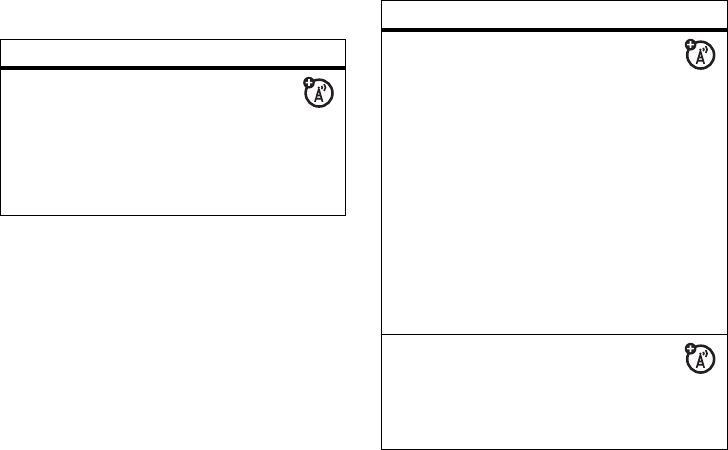
54
Settings & Tools Menu
DRAFT
Messages
Features
Send Text Message
Send a text message:
MENU
(
s
)
CMESSAGING
New Txt Msg
Press
Options
to perform various operations
on the message.
Send Multimedia (Pix/Flix)
Message
MENU
(
s
)
CMESSAGING
New Pix Msg
Enter the message address and press
OK
(
s
), then:
To insert a picture or video clip, scroll to the
Pix or Flix
entry area and press
Gallery
.
To insert a sound, scroll to the
Sound
entry
area and press
Sounds
.
For detailed instructions on sending a
multimedia message, see page 16
Store Message Objects
Go to a multimedia message slide,
then press
Options
.
Select
Save Picture
or
Save Sound
.
Features
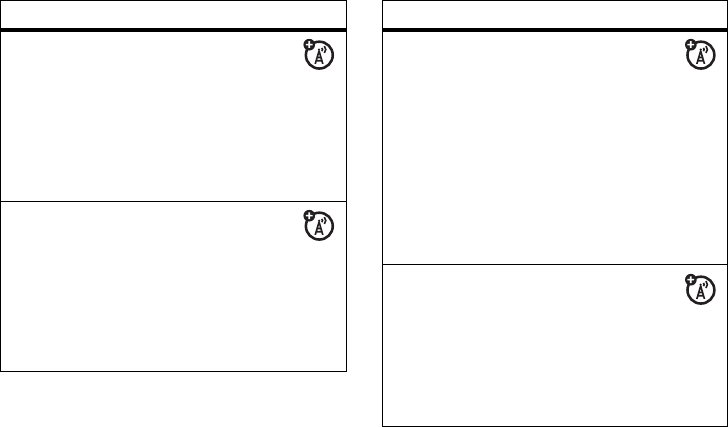
55
Settings & Tools Menu
DRAFT
View Sent Messages
View sent messages:
MENU
(
s
)
CMESSAGING
Sent
sent message, then press
Open
(
s
)
Press
Options
to perform various operations
on the message.
Read Received Messages
Read received messages:
MENU
(
s
)
CMESSAGING
Inbox
received message, then press
Open
(
s
)
Press
Options
to perform various operations
on the message.
Features
Drafts
View messages saved in
Drafts
folder:
MENU
(
s
)
CMESSAGING
Drafts
draft message
To edit the message, press
EDIT
(
s
).
To delete the message, press
Erase
.
Press
Options
to perform various operations
on the message.
Erase Messages
Delete all messages or only
messages from the
Outbox
or
Drafts
folder:
MENU
(
s
)
CMESSAGING
, then press
Options
.
Scroll to
Erase Inbox
,
Erase Drafts
,
Erase Sent
, or
Erase
All
, and press
OK
(
s
)
Features

56
Settings & Tools Menu
DRAFT
Contacts
Features
Create Entry
Create a new
Contacts
entry:
MENU
(
s
)
ECONTACTS
New Contact
View Contact
MENU
(
s
)
ECONTACTS
Contact List
entry
Press
View
.
Add Entries to Group
Tip:
You can add a
Contacts
entry to a group
while editing that entry by scrolling to
Group
and pressing
Set
.
MENU
(
s
)
ECONTACTS
Groups
Scroll to the desired group_name and press
Options
, then scroll to
Add
and press
OK
(
s
).
On the
ADD CONTACTS
screen, scroll to each
contact you want to add and press
OK
(
s
).
When you are finished adding contacts to a
group, press
Done
.
When you send a message to a group list,
the message goes to all
Contacts
entries in
that group.
Features

57
Settings & Tools Menu
DRAFT
Add Group
Add a new group as an entry on the
GROUPS
screen:
MENU
(
s
)
ECONTACTS
Groups
Press
New
.
You can add entries to or delete entries
from a group list. Use a preset group name
or create your own name.
When you send a message to a group list,
the message goes to all
Contacts
entries in
that group.
Features
Dial Number
Call a number stored in
Contacts
:
MENU
(
s
)
ECONTACTS
Contact List
entry
or
MENU
(
s
)
ECONTACTS
Groups
group_name
Press
N
to call.
Edit Entry
Edit a
Contacts
entry:
MENU
(
s
)
ECONTACTS
Contact List
entry
Press
Edit
.
Features

58
Settings & Tools Menu
DRAFT
Set Speed Dial Number
Assign a speed dial number to a
Contacts
entry:
MENU
(
s
)
ECONTACTS
Contact List
entry
Press
Edit
and scroll to the number to be
assigned a speed dial number. Press
Options
,
then scroll to
Set Speed Dial
and press
OK
(
s
).
Set Default Number for Entry
Set the default number for a
Contacts
entry
with multiple numbers:
MENU
(
s
)
ECONTACTS
Contact List
entry
Press
Edit
and scroll to the number to be set
as the default number. Press
Options
, then
scroll to
Set As Default
and press
OK
(
s
).
Features
Assign Ringer ID to Entry
Assign a distinctive ringtone to a
Contacts
entry:
MENU
(
s
)
ECONTACTS
Contact List
entry
Press
Edit
and scroll to
Ringtone
. Press
Set
to go
to the
TUNES & TONES
menu.
Scroll to the desired ringtone and press
OK
(
s
).
Your phone plays the assigned ringtone
when you receive a call from that entry, if
Ringer IDs
is set to
On
(see page 41).
Features

59
Settings & Tools Menu
DRAFT
Personalizing Features
Using Voice Commands
You can place calls and perform other tasks by
speaking commands to your phone.
1
Press and release the voice key on the
right side of the phone.
Your phone displays and speaks
Say a
command
, followed by a list of voice
commands.
Create New Ringtone
Create a recording that you can assign as a
ringtone for an entry:
MENU
(
s
)
ECONTACTS
Contact List
entry
Press
Edit
and scroll to
Ringtone
. Press
Set
to
go to the
TUNES & TONES
menu.
Select
Record New
and follow the prompts to
create a recording that is stored with your
other ringtones.
Download Ringtone
MENU
(
s
)
ECONTACTS
Contact List
entry
Press
Edit
and scroll to
Ringtone
. Press
Set
to
go to the
TUNES & TONES
menu.
Select
Get New
and then proceed to
download and save a ringtone.
Features
Erase Entry
Erase a
Contacts
entry:
MENU
(
s
)
ECONTACTS
Contact List
entry
Press
Options
, then scroll to
Erase
and press
OK
(
s
).
Features

60
Settings & Tools Menu
DRAFT
2
Say one of the commands listed in the
table below.
Your phone performs the corresponding
action.
Voice Commands
Call
Name or #
Place a call to:
•
a phone number you speak
or
•
a
Contacts
entry whose Name you
speak
Send Picture
Name or #
Send a multimedia message to:
•
a phone number you speak
or
•
a
Contacts
entry whose Name you
speak
(See page 14 for instructions on sending a
picture in a message.)
Send Text
Name or #
Send a text message to:
•
a phone number you speak
or
•
a
Contacts
entry whose Name you
speak
Voice Commands

61
Settings & Tools Menu
DRAFT
Tip:
When speaking the name of a
Contacts
entry, you must say the name exactly as it is
listed in the entry. For example, to call the
mobile number for a
Contacts
entry named Bill
Smith, you would say “Call Bill Smith mobile.”
(If the entry included only one number for Bill
Smith, you would simply say “Call Bill Smith.”)
Tip:
Speak numbers at a normal speed and
volume, pronouncing each digit distinctly.
Avoid pausing between digits.
Voice Service Setup
You can modify several voice command
settings:
1
Press and release the voice key on the
right side of the phone.
2
Press
Settings
.
3
Scroll to
Choice Lists
,
Sensitivity
,
Digit Dialing
,
Sound
, or
About
, and press
Select
.
To access
Help
information for the setting you
selected, press
Help
.
Lookup
Name
Look up a
Contacts
entry by speaking the
entry’s Name.
Go To
App
Use a voice shortcut to access the phone
App (application) you specify:
Voicemail
,
Camera
,
Redial
,
Received
Calls
Voice Commands
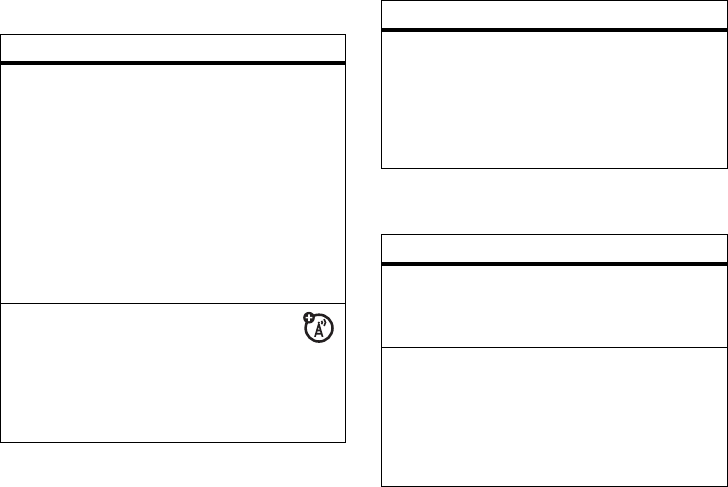
62
Settings & Tools Menu
DRAFT
More Personalizing Features
Menu Features
Features
Call & Key Volumes
MENU
(
s
)
DSETTINGS & TOOLS
Sounds Setting
Ring Styles
Tip:
If necessary, set
Style
to
Master Volume
:
Scroll to
Style
and press
Change
, then scroll to
Master Volume
and press
Select
.
With
Style
set to
Master Volume
, scroll to
Master
Volume Detail
and press
Change
, then scroll to
Ring Volume
or
Key Volume
and press
Change
.
Greeting
Change the greeting that appears
when you turn on your phone:
MENU
(
s
)
DSETTINGS & TOOLS
Display
Greeting
Display Themes
Set the colors and styles of screens that
your phone displays:
MENU
(
s
)
DSETTINGS & TOOLS
Display
Display Themes
Features
Menu Language
MENU
(
s
)
DSETTINGS & TOOLS
Initial Setup
Language
Show or Hide Menu Icons
Show or hide menu feature icons in the
home screen:
MENU
(
s
)
DSETTINGS & TOOLS
Display
Home Screen
Home Keys
Icons
Features

63
Settings & Tools Menu
DRAFT
Change Menu
Change the menu feature icons in the home
screen:
MENU
(
s
)
DSETTINGS & TOOLS
Display
Home Screen
Home Keys
Create Banner
Create a heading to display on your phone’s
home screen:
MENU
(
s
)
DSETTINGS & TOOLS
Display
Home Screen
Banner
Master Reset
Reset all options except unlock code,
security code, and lifetime timer:
MENU
(
s
)
DSETTINGS & TOOLS
Initial Setup
Master Reset
To reset all options, you need to enter the
Security Code
(000000).
Features
Master Clear
Reset all options except unlock code,
security code, and lifetime timer, and clear
all user settings and entries:
Warning:
This option erases all user-
entered information stored in your phone
memory, including phonebook entries and
downloaded files. Once you erase the
information, it cannot be recovered. It
resets all options to their factory settings
except for the unlock code, security code,
and lifetime timer.
MENU
(
s
)
DSETTINGS & TOOLS
Initial Setup
Master Clear
To reset all options, you need to enter the
Security Code
(000000).
Features
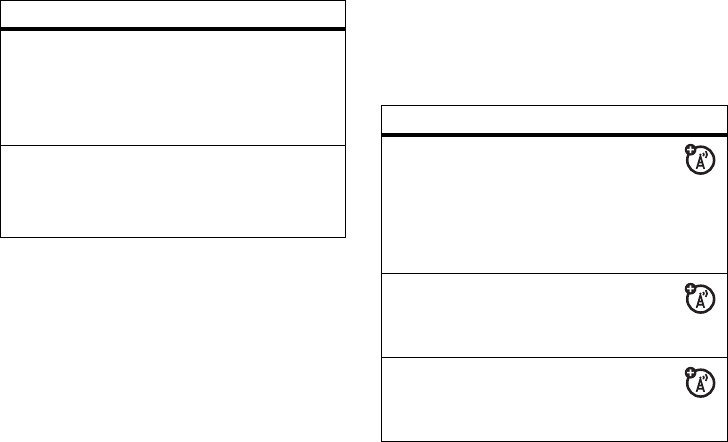
64
Settings & Tools Menu
DRAFT
Dialing Features
Call Monitoring
Network connection time
is the elapsed
time from the moment you connect to your
service provider's network to the moment
you end the call by pressing
O
. This time
includes busy signals and ringing.
The amount of network connection time
you track on your resettable timer may not
equal the amount of time for which you
are billed by your service provider. For
billing information, please contact your
service provider directly.
Features
Activate DTMF Tones
Activate DTMF tones:
MENU
(
s
)
DSETTINGS & TOOLS
Initial Setup
DTMF Tones
Send DTMF Tones
Send DTMF tones during a call:
Press number keys.
Features
View Call Times
MENU
(
s
)
ARECENT CALLS
View Timers
Scroll to
Last Call
,
All Calls
,
Received Calls
,
Dialed
Calls
, or
Lifetime Calls
, and press
OK
(
s
).
View Roaming Times
MENU
(
s
)
ARECENT CALLS
View Timers
Roaming
Set In-Call Timer
MENU
(
s
)
DSETTINGS & TOOLS
Call Settings
In-Call Setup
In-Call Timer
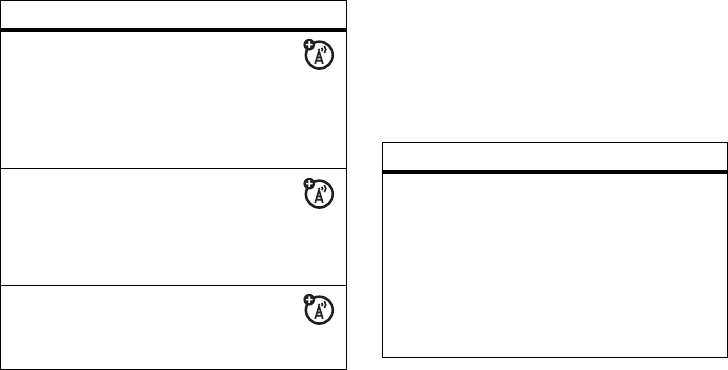
65
Settings & Tools Menu
DRAFT
Handsfree Features
Note:
The use of wireless devices and their
accessories may be prohibited or restricted in
certain areas. Always obey the laws and
regulations on the use of these products.
View Data Volumes
MENU
(
s
)
ARECENT CALLS
View Timers
Scroll to
Transmit Kilobytes
,
Received Kilobytes
,
Total
Kilobytes
, or
Lifetime Data
, and press
OK
(
s
).
Reset Timer
MENU
(
s
)
ARECENT CALLS
View Timers
Scroll to the desired timer and press
Reset
.
View Last Reset
MENU
(
s
)
ARECENT CALLS
View Timers
Last Reset
Features
Features
Accessory Volume Settings
(car kit or headset)
Adjust volume of headsets or car kit
accessories that are enabled for Bluetooth
connections:
During an active call, press your phone’s up
or down volume key.
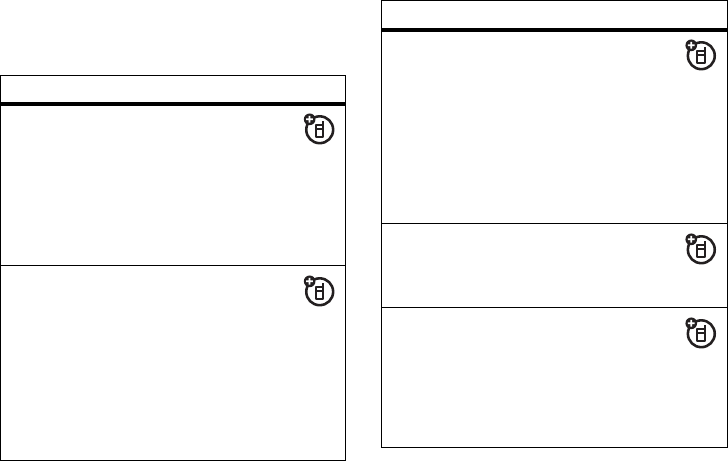
66
Settings & Tools Menu
DRAFT
Bluetooth
®
Wireless
Connections
Features
Make Phone Visible to Other
Device
Allow an unknown Bluetooth device to
discover your phone:
MENU
(
s
)
DSETTINGS & TOOLS
Connections
Bluetooth
Setup
Find Me
Connect to Recognized Device
Connect to a recognized handsfree
device:
MENU
(
s
)
DSETTINGS & TOOLS
Connections
Bluetooth
Handsfree
device_name
where device_name is the name of the
device to which you want to connect.
Connect to a Handsfree Device
During a Call
Switch to a headset or car kit during a call:
MENU
(
s
)
Use Bluetooth
Note:
You cannot switch to a headset or car
kit if you are already connected to a
Bluetooth device.
Disconnect from Device
Highlight the device name and press
DROP
.
Edit Device Properties
Edit the properties of a recognized
device:
MENU
(
s
)
DSETTINGS & TOOLS
Connections
Bluetooth
Device History
Edit
Features
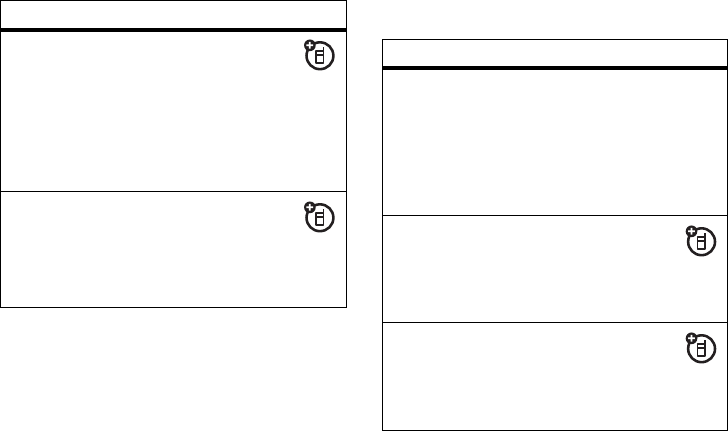
67
Settings & Tools Menu
DRAFT
Data and Fax Calls
Set Bluetooth Power Permanently
On
Set
Bluetooth Power
to be on whenever your
phone is on:
MENU
(
s
)
DSETTINGS & TOOLS
Connections
Bluetooth
Setup
Power
On
Set Bluetooth Options
Set your phone’s Bluetooth options:
MENU
(
s
)
DSETTINGS & TOOLS
Connections
Bluetooth
Setup
Features
Features
Data Settings
Specify call type for next call:
MENU
(
s
)
DSETTINGS & TOOLS
Connections
Incoming Call
Select
Normal
,
Data In Only
, or
Fax In Only
.
Send Data or Fax
Connect your phone to the device,
then place the call through the device
application.
Receive Data or Fax
Connect your phone to the device,
then answer the call through the device
application.
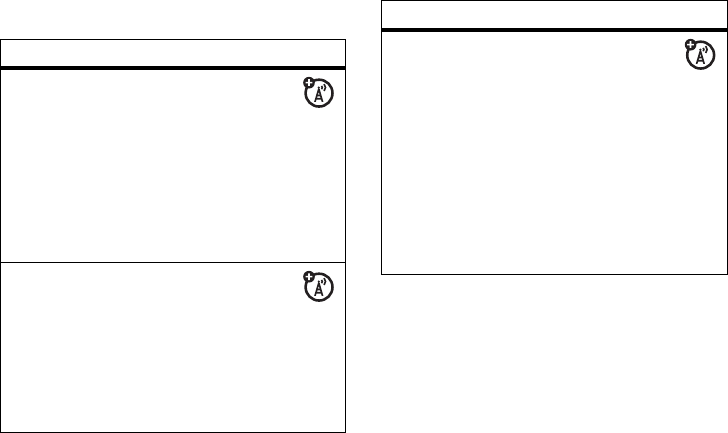
68
Settings & Tools Menu
DRAFT
Network Features
Features
Network Settings
View network information and adjust
network settings:
MENU
(
s
)
DSETTINGS & TOOLS
System
System Select
Scroll to
Current Network
and press
View
, or
scroll to
Set Mode
and press
Change
.
Set Service Tones
Set phone to beep each time the
network registration status changes:
MENU
(
s
)
DSETTINGS & TOOLS
System
System Select
Scroll to
Service Tone
and press
Change
.
Set Call Drop Alerts
Set phone to emit an alert tone
whenever the network drops a call.
(Because digital networks are so quiet,
the call drop alert may be your only
indication that a call has been dropped.)
MENU
(
s
)
DSETTINGS & TOOLS
System
System Select
Scroll to
Call Drop Tone
and press
Change
.
Features

69
Settings & Tools Menu
DRAFT
Personal Organizer
Features
Features
Add Calendar Appointment
Add an event to the calendar:
MENU
(
s
)
DSETTINGS & TOOLS
Tools
Calendar
Scroll to the desired date and press
Add
,
then enter new event information.
View Calendar Appointment
MENU
(
s
)
DSETTINGS & TOOLS
Tools
Calendar
Scroll to the date of the scheduled
appointment, press
VIEW
(
s
), then press
VIEW
(
s
) again to view appointment
details.
Set Alarm
Set an alarm:
MENU
(
s
)
DSETTINGS & TOOLS
Tools
Alarm Clock
Tu rn O f f A l a rm
Turn off alarm:
Press
Off
or
O
.
View World Clock
View current time in cities around the
world:
MENU
(
s
)
DSETTINGS & TOOLS
Tools
World Clock
Calculator
Calculate numbers:
MENU
(
s
)
DSETTINGS & TOOLS
Tools
Calculator
Features
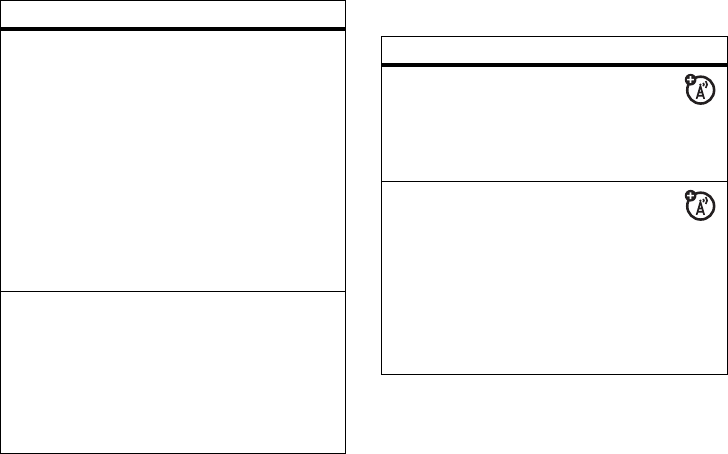
70
Settings & Tools Menu
DRAFT
Security News and
Entertainment
Features
Control Access to Location Function
Set up a location lock code to control
access to
Location
function (see “Hiding or
Showing Location Information” on
page 44):
MENU
(
s
)
DSETTINGS & TOOLS
System
Security
New Passwords
Scroll to
Location Code
and press
Change
. If
prompted to enter the old location code,
enter the code and press
Ok
.
Change Unlock & Security Codes
MENU
(
s
)
DSETTINGS & TOOLS
System
Security
New Passwords
Scroll to
Unlock Code
or
Security Code
and press
Change
. If prompted, enter the old code and
press
Ok
.
Features
Launch Game or Application
Launch a
Get It Now
game or
application:
MENU
(
s
)
BGETITNOW
application
Download Game or Application
Download a
Get It Now
game or
application:
MENU
(
s
)
BGETITNOW
Select category, application, and pricing
option. Normal airtime and/or carrier usage
charges apply.
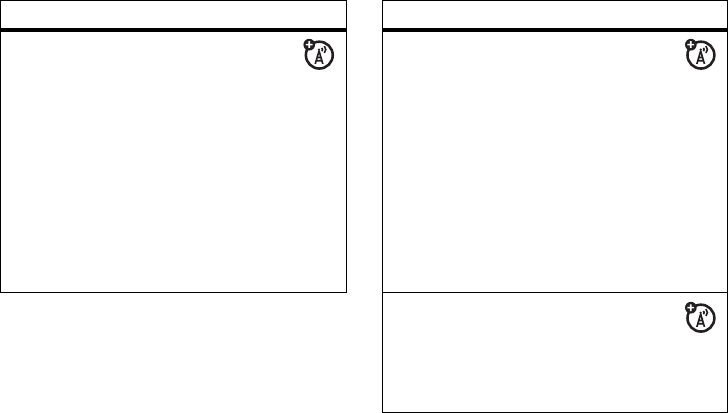
71
Settings & Tools Menu
DRAFT
Manage Pictures
From the idle display, press
S
left to
select
GET PIX & FLIX
. Scroll to
My PIX
and press
OK
(
s
) to view a list of pictures.
To view a picture, scroll to the picture title
and press
VIEW
(
s
).
To access the
OPTIONS
menu for
MY PIX
, press
Options
. Scroll to and select the desired
option:
Send
,
To PIX Place
,
Get New
,
Set As
,
Rename
,
Lock
,
Erase
,
Erase All
, or
PIX Info
.
Features
Manage Video Clips
From the idle display, press
S
left to
select
GET PIX & FLIX
. Scroll to
My FLIX
and
press
OK
(
s
) to view a list of pictures.
To play a video clip, scroll to the video clip
title and press
PLAY
(
s
).
To access the
OPTIONS
menu for
MY PIX
, press
Options
. Scroll to and select the desired
option:
Send
,
To PIX Place
,
Get New
,
Rename
,
Lock
,
Erase
,
Erase All
,
Flix Info
.
Web Sessions
Select or create a Web session:
From the idle display, press
S
up to
select
OPENWAVE
.
Features

72
Service & Repairs
DRAFT
Service & Repairs
If you have questions or need assistance,
we’re here to help. Go to
www.motorola.com/consumer/support
,
where you can select from a number of
customer care options. You can also contact
the Motorola Customer Support Center at 1-
800-657-8909 (United States), 1-888-390-6456
(TTY/TDD United States for hearing impaired),
or 1-800-461-4575 (Canada).

SAR Data
73
DRAFT
Specific Absorption Rate Data
SAR Da ta
This model wireless phone meets the
government’s requirements for
exposure to radio waves.
Your wireless phone is a radio transmitter and
receiver. It is designed and manufactured not to
exceed limits for exposure to radio frequency (RF)
energy set by the Federal Communications
Commission (FCC) of the U.S. Government and by the
Canadian regulatory authorities. These limits are part
of comprehensive guidelines and establish permitted
levels of RF energy for the general population. The
guidelines are based on standards that were
developed by independent scientific organizations
through periodic and thorough evaluation of scientific
studies. The standards include a substantial safety
margin designed to assure the safety of all persons,
regardless of age or health.
The exposure standard for wireless mobile phones
employs a unit of measurement known as the
Specific Absorption Rate, or SAR. The SAR limit set
by the FCC and by the Canadian regulatory
authorities is 1.6 W/kg.
1
Tests for SAR are conducted
using standard operating positions accepted by the
FCC and by Industry Canada with the phone
transmitting at its highest certified power level in all
tested frequency bands. Although the SAR is
determined at the highest certified power level, the
actual SAR level of the phone while operating can be
well below the maximum value. This is because the
phone is designed to operate at multiple power
levels so as to use only the power required to reach
the network. In general, the closer you are to a
wireless base station, the lower the power output.
Before a phone model is available for sale to the
public in the U.S. and Canada, it must be tested and
74
SAR Data
DRAFT
certified to the FCC and Industry Canada that it does
not exceed the limit established by each government
for safe exposure. The tests are performed in
positions and locations (e.g., at the ear and worn on
the body) reported to the FCC and available for
review by Industry Canada. The highest SAR value for
this model phone when tested for use at the ear is
1.03 W/kg, and when worn on the body, as described
in this user guide, is 0.84 W/kg. (Body-worn
measurements differ among phone models,
depending upon available accessories and regulatory
requirements).
2
While there may be differences between the SAR
levels of various phones and at various positions,
they all meet the governmental requirements for safe
exposure. Please note that improvements to this
product model could cause differences in the SAR
value for later products; in all cases, products are
designed to be within the guidelines.
Additional information on Specific Absorption Rates
(SAR) can be found on the Cellular
Telecommunications & Internet Association (CTIA)
Web site:
http://www.phonefacts.net
or the Canadian Wireless Telecommunications
Association (CWTA) Web site:
http://www.cwta.ca
1. In the United States and Canada, the SAR limit for
mobile phones used by the public is 1.6 watts/kg
(W/kg) averaged over one gram of tissue. The standard
incorporates a substantial margin of safety to give
additional protection for the public and to account for
any variations in measurements.
2. The SAR information includes the Motorola testing
protocol, assessment procedure, and measurement
uncertainty range for this product.

75
Index
DRAFT
Index
1-touch dial
using 50
1X indicator 26
A
accessories 6
alarm clock 69
alarm on indicator 27
alarm only indicator 27
alert
downloading 54
setting 40
turning off 10, 11
ALI indicators 44
all sound off indicator 27
animation
downloading 54
screen saver 43
viewing 71
wallpaper 42
answering a call 10, 42
automatic location
information
sending 44
automatic redial 46
B
battery 7
charging 8
extending battery life 43,
45
installing 7
battery level indicator 27
C
calculator 69
calendar 69
view appointment 69
calendar appointment
indicator 27
call
alert, setting 40
alert, turning off 10, 11
answer options 42
answering 10
deleting 48
dialed calls list 48
dialing 10
emergency number 47
ending 10
handsfree speaker 36
making 10
received calls list 48
receiving 10
76
Index
DRAFT
call (continued)
recent calls 48
storing 48
unanswered call 49
Call Failed, Number Busy
message 46
camera 12
taking a photo 14
character chart 33
codes
changing 38
default 9, 38, 39
forgetting 39
Contacts
1-touch dial 50
attaching 2 numbers 50
dialing a number 57
editing an entry 57
ringtone 58
speak entry 41
speed dial number 50
storing an entry 56
D
data call 67
volume meters 65
data call, tethered,
embedded WAP/
BREW indicator 26
deleting a call 48
dialed calls list 48
dialing a number 10
digital indicator 26
display
greeting 62
dormant indicator 26
drafts folder 55
DTMF tones
activating 64
sending 64
E
E911 indicator 27
earpiece volume 10
emergency number 47
end key 10
ending a call 10
Enter Unlock Code message
39
external display 37
F
fax call 67
5-way navigation key 28
flip
external display 37
open to answer 10
G
greeting 62
H
handsfree speaker 36
home screen 25
77
Index
DRAFT
I
indicators
1X 26
alarm on 27
alarm only 27
ALI 44
all sounds off 27
battery level 27
calendar appointment 27
data call, tethered,
embedded WAP/
BREW 26
digital 26
dormant 26
E911 27
keypad lock 27
location on 27
message 27
message waiting 18
missed call 49
missed calls 27
no service 26
roaming 26
signal strength 26
sound on & vibrate on 27
speakerphone 27
SSL 26
TTY 26
vibrate on 27
voice call 26
voice privacy 26
voicemail 27
K
key
end 10
5-way navigation 28
left soft key 25
menu 6
power 10
right soft key 25
send 10, 48
volume control 10
keypad lock indicator 27
L
left soft key
functions 25
location on indicator 27
location, sending to network
44
lock
phone 39
M
making a call 10
menu
entering text 30
lists 29
navigating 28
using features 29
menu key 6
message
drafts 55
erase 55
outbox 55
78
Index
DRAFT
message (continued)
reading 55
status 55
text 54
message indicator 27
message waiting indicator
18
missed call indicator 49
missed calls indicator 27
Missed Calls message 49
multimedia message
receiving 18
sending 16
my telephone number 11
N
network settings 68
no service indicator 26
number
viewing your number 11
O
optional accessory 6
optional feature 6
outbox 55
P
passwords. See codes
phone
alert, setting 40
alert, turning off 10, 11
answer options 42
automatic location
information 44
codes 38
flip 10
location 44
locking 39
network settings 68
security code 38
unlock code 38
unlocking 9, 39
phone number
attaching 2 numbers 50
redialing 46
storing in Contacts 56
viewing your number 11
photo
downloading 54
sending 14
taking 14
picture
downloading 54
screen saver 43
viewing 71
wallpaper 42
power key 10
R
received calls list 48
recent calls 48
redial
automatic redial 46
busy number 46
79
Index
DRAFT
right soft key
functions 25
ring alert
setting 11, 40
turning off 10, 11
ringer volume, setting 10
ringtone
downloading 54
roaming indicator 26
S
screen saver 43
security code
changing 38
default 38
forgetting 39
send key 10, 48
signal strength indicator 26
silent alert, setting 11, 40
soft keys
functions 25
sound
downloading 54
sound on & vibrate on
indicator 27
speak Contact list entry 41
speak keypad digits 41
Speaker On message 36
speakerphone indicator 27
speed dial 50
SSL indicator 26
standby time, increasing 43
storing a call 48
T
talking phone 41
telephone number
viewing your number 11
text
character chart 33
entering 30
entry mode, selecting 31
text entry mode
selecting 31
TTY indicator 26
U
unlock
phone 39
unlock code
bypassing 39
changing 38
default 9, 38, 39
entering 9
V
vibrate alert
setting 40
turning off 10, 11
vibrate on indicator 27
video clip 12
vObject, defined 19
voice call indicator 26
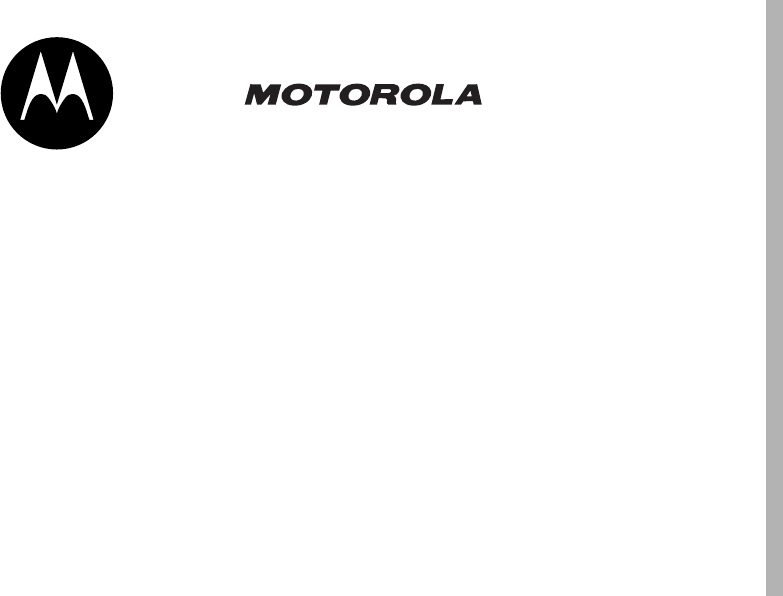
IMPORTANT SAFETY AND LEGAL INFORMATION >
Cover.Print.Front.Legal.Landscape.Eng.fm Page 1 Wednesday, July 6, 2005 9:51 AM

A-2
Software Copyright Notice
The Motorola products described in this manual may
include copyrighted Motorola and third-party
software stored in semiconductor memories or other
media. Laws in the United States and other countries
preserve for Motorola and third-party software
providers certain exclusive rights for copyrighted
software, such as the exclusive rights to distribute or
reproduce the copyrighted software. Accordingly, any
copyrighted software contained in the Motorola
products may not be modified, reverse-engineered,
distributed, or reproduced in any manner to the
extent allowed by law. Furthermore, the purchase of
the Motorola products shall not be deemed to grant
either directly or by implication, estoppel, or
otherwise, any license under the copyrights, patents,
or patent applications of Motorola or any third-party
software provider, except for the normal,
non-exclusive, royalty-free license to use that arises
by operation of law in the sale of a product.
Manual Number: 6809497A59-O

A-3
Contents
Contents
Safety Information . . . . . . . . . . . . . . . . . . . . . . . . . 4
Exposure To Radio Frequency (RF) Energy . . . . . . 4
Operational Precautions . . . . . . . . . . . . . . . . . . . . 4
RF Energy Interference/Compatibility . . . . . . . . . 5
Driving Precautions. . . . . . . . . . . . . . . . . . . . . . . . 7
Operational Warnings . . . . . . . . . . . . . . . . . . . . . 7
Choking Hazards . . . . . . . . . . . . . . . . . . . . . . . . . . 8
Glass Parts . . . . . . . . . . . . . . . . . . . . . . . . . . . . . . 9
Seizures/Blackouts . . . . . . . . . . . . . . . . . . . . . . . . 9
Repetitive Motion. . . . . . . . . . . . . . . . . . . . . . . . . 9
Warranty . . . . . . . . . . . . . . . . . . . . . . . . . . . . . . . . 10
What Does this Warranty Cover?. . . . . . . . . . . . 10
Who Is Covered?. . . . . . . . . . . . . . . . . . . . . . . . . 13
What Will Motorola Do? . . . . . . . . . . . . . . . . . . 13
How to Obtain Warranty
Service or Other Information . . . . . . . . . . . . . . . 13
What Other Limitations Are There? . . . . . . . . . . 14
Hearing Aid Compatibility . . . . . . . . . . . . . . . . . 16
WHO Information . . . . . . . . . . . . . . . . . . . . . . . . . 18
Product Registration . . . . . . . . . . . . . . . . . . . . . . 18
Export Law Assurances . . . . . . . . . . . . . . . . . . . 19
Wireless: The New Recyclable . . . . . . . . . . . . 19
Smart Practices While Driving . . . . . . . . . . . . . 20

A-4
Safety Information
Safety and General Information
Safe ty Infor mation
This section contains important information on
the safe and efficient operation of your mobile
device. Read this information before using your
mobile device.
*
Exposure To Radio Frequency
(RF) Energy
Your mobile device contains a transmitter and
receiver. When it is ON, it receives and transmits RF
energy. When you communicate with your mobile
device, the system handling your call controls the
power level at which your mobile device transmits.
Your Motorola mobile device is designed to comply
with local regulatory requirements in your country
concerning exposure of human beings to RF energy.
Operational Precautions
For optimal mobile device performance and to be
sure that human exposure to RF energy does not
exceed the guidelines set forth in the relevant
standards, always follow these instructions and
precautions.
External Antenna Care
If your mobile device has an external antenna, use
only a Motorola-supplied or approved replacement
antenna. Use of unauthorized antennas,
modifications, or attachments could damage the
mobile device and/or may result in your device not
* The information provided in this document supersedes
the general safety information in user’s guides
published prior to September 1, 2005.

A-5
Safety Information
complying with local regulatory requirements in your
country.
DO NOT hold the external antenna when the mobile
device is IN USE. Holding the external antenna
affects call quality and may cause the mobile device
to operate at a higher power level than needed.
Product Operation
When placing or receiving a phone call, hold your
mobile device just like you would a landline phone.
If you wear the mobile device on your body, always
place the mobile device in a Motorola-supplied or
approved clip, holder, holster, case, or body harness.
If you do not use a body-worn accessory supplied or
approved by Motorola, keep the mobile device and its
antenna at least 2.5 centimeters (1 inch) from your
body when transmitting.
When using any data feature of the mobile device,
with or without an accessory cable, position the
mobile device and its antenna at least
2.5 centimeters (1 inch) from your body.
Using accessories not supplied or approved by
Motorola may cause your mobile device to exceed RF
energy exposure guidelines. For a list of
Motorola-supplied or approved accessories, visit our
website at
www.motorola.com
.
RF Energy
Interference/Compatibility
Nearly every electronic device is subject to RF energy
interference from external sources if inadequately
shielded, designed, or otherwise configured for RF
energy compatibility. In some circumstances your
mobile device may cause interference with other
devices.
This device complies with Part 15 of the FCC Rules.
Operation is subject to the following two conditions:
(1) this device may not cause harmful interference,
and (2) this device must accept any interference
received, including interference that may cause
undesired operation.

A-6
Safety Information
Follow Instructions to Avoid
Interference Problems
Turn off your mobile device in any location where
posted notices instruct you to do so. These locations
include hospitals or health care facilities that may be
using equipment that is sensitive to external RF
energy.
In an aircraft, turn off your mobile device whenever
instructed to do so by airline staff. If your mobile
device offers an airplane mode or similar feature,
consult airline staff about using it in flight.
Pacemakers
If you have a pacemaker, consult your physician
before using this device.
Persons with pacemakers should observe the
following precautions:
•
ALWAYS keep the mobile device more than
20 centimeters (8 inches) from your
pacemaker when the mobile device is turned
ON.
•
DO NOT carry the mobile device in the breast
pocket.
•
Use the ear opposite the pacemaker to
minimize the potential for interference.
•
Turn OFF the mobile device immediately if
you have any reason to suspect that
interference is taking place.
Hearing Aids
Some digital mobile devices may interfere with some
hearing aids. In the event of such interference, you
may want to consult your hearing aid manufacturer or
physician to discuss alternatives.
Other Medical Devices
If you use any other personal medical device, consult
your physician or the manufacturer of your device to
determine if it is adequately shielded from RF energy.

A-7
Safety Information
Driving Precautions
Check the laws and regulations on the use of mobile
devices in the area where you drive. Always obey
them.
When using your mobile device while driving, please:
•
Give full attention to driving and to the road.
Using a mobile device may be distracting.
Discontinue a call if you can’t concentrate on
driving.
•
Use handsfree operation, if available.
•
Pull off the road and park before making or
answering a call if driving conditions so
require.
Responsible driving practices can be found in the
“Smart Practices While Driving” section at the end of
this guide and/or at the Motorola website:
www.motorola.com/callsmart
.
Operational Warnings
Obey all posted signs when using mobile devices in
public areas, such as health care facilities or blasting
areas.
Automobile Air Bags
Do not place a mobile device in the air bag
deployment area.
Potentially Explosive Atmospheres
Areas with potentially explosive atmospheres are
often but not always posted, and can include fueling
areas such as below decks on boats, fuel or chemical
transfer or storage facilities, or areas where the air
contains chemicals or particles, such as grain, dust,
or metal powders.
When you are in such an area, turn off your mobile
device, and do not remove, install, or charge
batteries. In such areas, sparks can occur and cause
an explosion or fire.
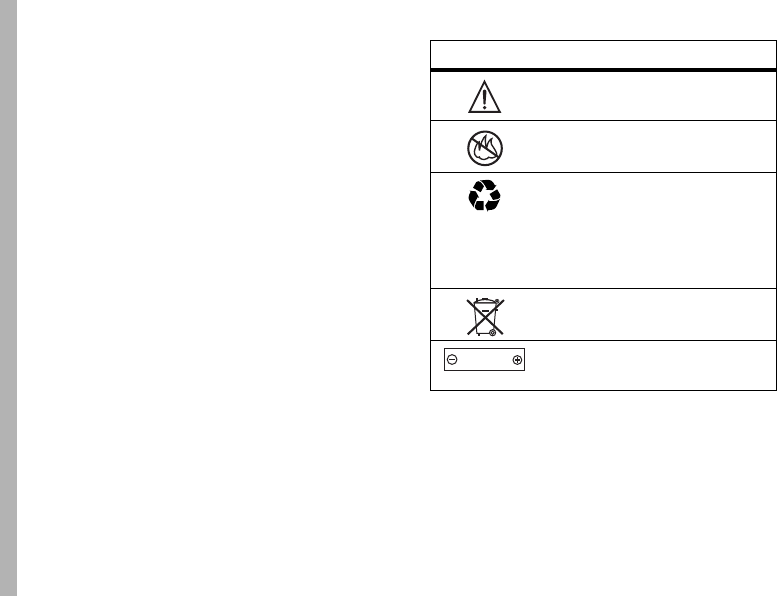
A-8
Safety Information
Damaged Products
If your mobile device or battery has been submerged
in water, punctured, or subjected to a severe fall, do
not use it until you take it to a Motorola Authorized
Service Center. Do not attempt to dry it with an
external heat source, such as a microwave oven.
Batteries and Chargers
If jewelry, keys, beaded chains, or other conductive
materials touch exposed battery terminals, this could
complete an electrical circuit (short circuit), become
very hot, and could cause damage or injury. Be
careful when handling a charged battery, particularly
when placing it inside a pocket, purse, or other
container with metal objects.
Use only
Motorola Original ™ batteries and chargers.
Caution:
To avoid risk of personal injury, do not
dispose of your battery in a fire.
Your battery, charger, or mobile device may contain
symbols, defined as follows:
Choking Hazards
Your mobile device or its accessories may include
detachable parts, which may present a choking
hazard to small children. Keep your mobile device
and its accessories away from small children.
Symbol Definition
Important safety information
follows.
Do not dispose of your battery or
mobile device in a fire.
Your battery or mobile device may
require recycling in accordance
with local laws. Contact your local
regulatory authorities for more
information.
Do not throw your battery or
mobile device in the trash.
Your mobile device contains an
internal lithium ion battery.
032374o
032376o
032375o
032377o
032378o
Li Ion BATT

A-9
Safety Information
Glass Parts
Some parts of your mobile device may be made of
glass. This glass could break if the product is dropped
on a hard surface or receives a substantial impact. If
glass breaks, do not touch or attempt to remove. Stop
using your mobile device until the glass is replaced
by a qualified service center.
Seizures/Blackouts
Some people may be susceptible to epileptic seizures
or blackouts when exposed to flashing lights, such as
when playing video games. These may occur even if
a person has never had a previous seizure or
blackout.
If you have experienced seizures or blackouts, or if
you have a family history of such occurrences, please
consult with your physician before playing video
games or enabling a flashing-lights feature (if
available) on your mobile device.
Discontinue use and consult a physician if any of the
following symptoms occur: convulsion, eye or muscle
twitching, loss of awareness, involuntary
movements, or disorientation. It is always a good
idea to hold the screen away from your eyes, leave
the lights on in the room, take a 15-minute break
every hour, and stop use if you are very tired.
Repetitive Motion
When you repetitively perform actions such as
pressing keys or entering finger-written characters,
you may experience occasional discomfort in your
hands, arms, shoulders, neck, or other parts of your
body. If you continue to have discomfort during or
after such use, stop use and see a physician.
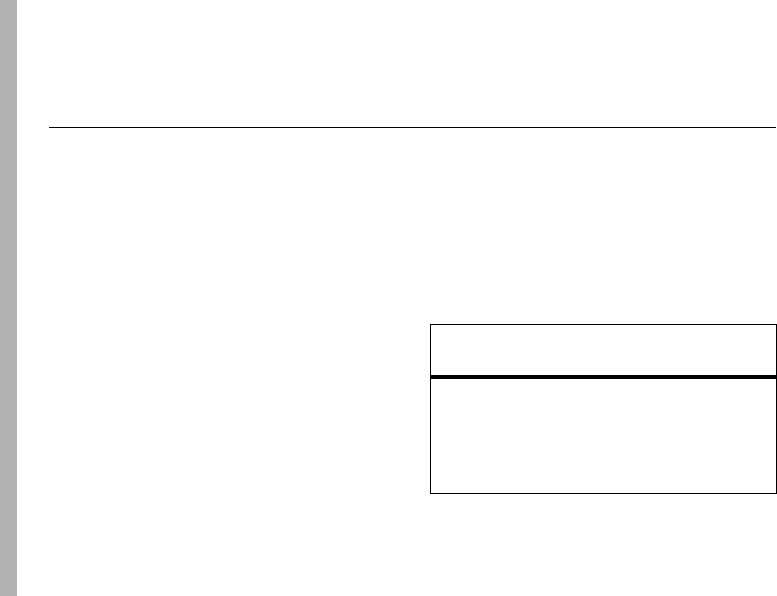
A-10
Warranty
Motorola Limited Warranty for the United States
and Canada
Warran ty
What Does this Warranty
Cover?
Subject to the exclusions contained below, Motorola,
Inc. warrants its telephones, pagers, messaging
devices, and consumer and professional two-way
radios (excluding commercial, government or
industrial radios) that operate via Family Radio
Service or General Mobile Radio Service,
Motorola-branded or certified accessories sold for
use with these Products (“Accessories”) and
Motorola software contained on CD-ROMs or other
tangible media and sold for use with these Products
(“Software”) to be free from defects in materials and
workmanship under normal consumer usage for the
period(s) outlined below. This limited warranty is a
consumer's exclusive remedy, and applies as follows
to new Motorola Products, Accessories and Software
purchased by consumers in the United States or
Canada, which are accompanied by this written
warranty:
Products and Accessories
Products
Covered
Length of Coverage
Products and
Accessories
as
defined above,
unless otherwise
provided for below.
One (1) year
from the date
of purchase by the first
consumer purchaser of the
product unless otherwise
provided for below.
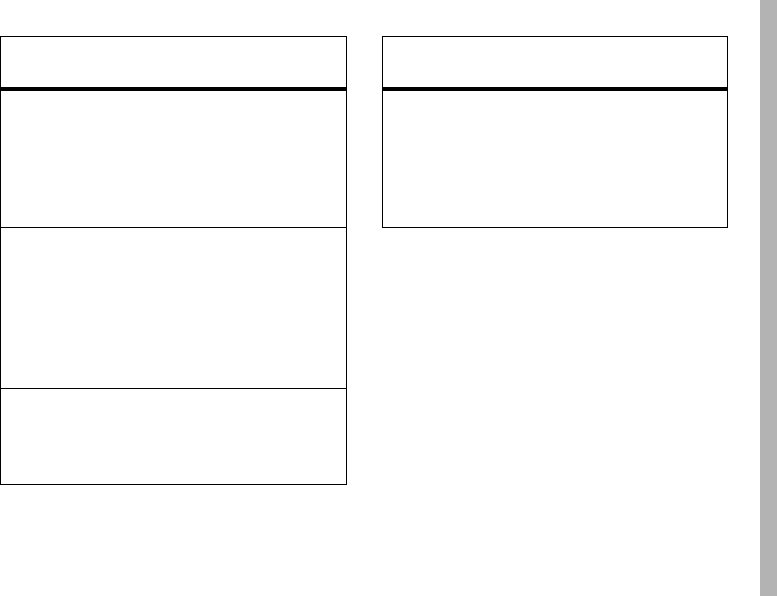
A-11
Warranty
Exclusions
Normal Wear and Tear.
Periodic maintenance,
repair and replacement of parts due to normal wear
and tear are excluded from coverage.
Batteries.
Only batteries whose fully charged
capacity falls below 80% of their rated capacity and
batteries that leak are covered by this limited
warranty.
Abuse & Misuse.
Defects or damage that result
from: (a) improper operation, storage, misuse or
abuse, accident or neglect, such as physical damage
(cracks, scratches, etc.) to the surface of the product
Decorative
Accessories and
Cases.
Decorative
covers, bezels,
PhoneWrap™
covers and cases.
Limited lifetime warranty
for the lifetime of ownership
by the first consumer
purchaser of the product.
Monaural
Headsets.
Ear
buds and boom
headsets that
transmit mono
sound through a
wired connection.
Limited lifetime warranty
for the lifetime of ownership
by the first consumer
purchaser of the product.
Consumer and
Professional
Two-Way Radio
Accessories.
Ninety (90) days
from the
date of purchase by the first
consumer purchaser of the
product.
Products
Covered
Length of Coverage
Products and
Accessories that
are Repaired or
Replaced.
The balance of the
original warranty or for
ninety (90) days
from the
date returned to the
consumer, whichever is
longer.
Products
Covered
Length of Coverage
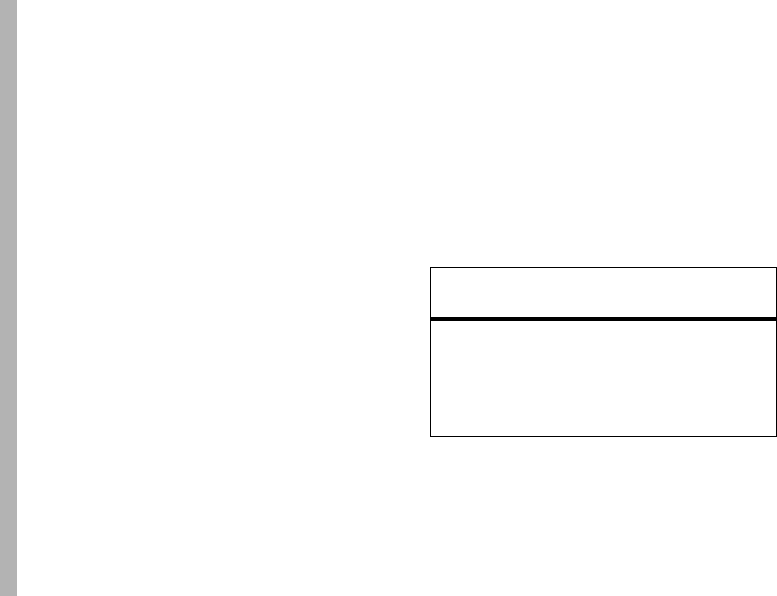
A-12
Warranty
resulting from misuse; (b) contact with liquid, water,
rain, extreme humidity or heavy perspiration, sand,
dirt or the like, extreme heat, or food; (c) use of the
Products or Accessories for commercial purposes or
subjecting the Product or Accessory to abnormal
usage or conditions; or (d) other acts which are not
the fault of Motorola, are excluded from coverage.
Use of Non-Motorola Products and
Accessories.
Defects or damage that result from
the use of Non-Motorola branded or certified
Products, Accessories, Software or other peripheral
equipment are excluded from coverage.
Unauthorized Service or Modification.
Defects
or damages resulting from service, testing,
adjustment, installation, maintenance, alteration, or
modification in any way by someone other than
Motorola, or its authorized service centers, are
excluded from coverage.
Altered Products.
Products or Accessories with
(a) serial numbers or date tags that have been
removed, altered or obliterated; (b) broken seals or
that show evidence of tampering; (c) mismatched
board serial numbers; or (d) nonconforming or
non-Motorola housings, or parts, are excluded from
coverage.
Communication Services.
Defects, damages, or
the failure of Products, Accessories or Software due
to any communication service or signal you may
subscribe to or use with the Products Accessories or
Software is excluded from coverage.
Software
Exclusions
Software Embodied in Physical Media.
No
warranty is made that the software will meet your
requirements or will work in combination with any
Products Covered Length of
Coverage
Software.
Applies only to
physical defects in the
media that embodies the
copy of the software (e.g.
CD-ROM, or floppy disk).
Ninety (90) days
from the date of
purchase.

A-13
Warranty
hardware or software applications provided by third
parties, that the operation of the software products
will be uninterrupted or error free, or that all defects
in the software products will be corrected.
Software NOT Embodied in Physical Media.
Software that is not embodied in physical media (e.g.
software that is downloaded from the internet), is
provided “as is” and without warranty.
Who Is Covered?
This warranty extends only to the first consumer
purchaser, and is not transferable.
What Will Motorola Do?
Motorola, at its option, will at no charge repair,
replace or refund the purchase price of any Products,
Accessories or Software that does not conform to
this warranty. We may use functionally equivalent
reconditioned/refurbished/pre-owned or new
Products, Accessories or parts. No data, software or
applications added to your Product, Accessory or
Software, including but not limited to personal
contacts, games and ringer tones, will be reinstalled.
To avoid losing such data, software and applications
please create a back up prior to requesting service.
How to Obtain Warranty
Service or Other Information
USA Phones
1-800-331-6456
Pagers
1-800-548-9954
Two-Way Radios and Messaging
Devices
1-800-353-2729
Canada All Products
1-800-461-4575
TTY
1-888-390-6456

A-14
Warranty
You will receive instructions on how to ship the
Products, Accessories or Software, at your expense,
to a Motorola Authorized Repair Center. To obtain
service, you must include: (a) a copy of your receipt,
bill of sale or other comparable proof of purchase;
(b) a written description of the problem; (c) the name
of your service provider, if applicable; (d) the name
and location of the installation facility (if applicable)
and, most importantly; (e) your address and
telephone number.
What Other Limitations Are
There?
ANY IMPLIED WARRANTIES, INCLUDING WITHOUT
LIMITATION THE IMPLIED WARRANTIES OF
MERCHANTABILITY AND FITNESS FOR A
PARTICULAR PURPOSE, SHALL BE LIMITED TO THE
DURATION OF THIS LIMITED WARRANTY,
OTHERWISE THE REPAIR, REPLACEMENT, OR
REFUND AS PROVIDED UNDER THIS EXPRESS
LIMITED WARRANTY IS THE EXCLUSIVE REMEDY OF
THE CONSUMER, AND IS PROVIDED IN LIEU OF ALL
OTHER WARRANTIES, EXPRESS OR IMPLIED. IN NO
EVENT SHALL MOTOROLA BE LIABLE, WHETHER IN
CONTRACT OR TORT (INCLUDING NEGLIGENCE) FOR
DAMAGES IN EXCESS OF THE PURCHASE PRICE OF
THE PRODUCT, ACCESSORY OR SOFTWARE, OR FOR
ANY INDIRECT, INCIDENTAL, SPECIAL OR
CONSEQUENTIAL DAMAGES OF ANY KIND, OR
LOSS OF REVENUE OR PROFITS, LOSS OF BUSINESS,
LOSS OF INFORMATION OR DATA, SOFTWARE OR
APPLICATIONS OR OTHER FINANCIAL LOSS ARISING
OUT OF OR IN CONNECTION WITH THE ABILITY OR
INABILITY TO USE THE PRODUCTS, ACCESSORIES
OR SOFTWARE TO THE FULL EXTENT THESE
DAMAGES MAY BE DISCLAIMED BY LAW.
Some states and jurisdictions do not allow the
limitation or exclusion of incidental or
consequential damages, or limitation on the
length of an implied warranty, so the above
For
Accessories
and
Software
, please call the
telephone number designated above for the
product with which they are used.

A-15
Warranty
limitations or exclusions may not apply to you.
This warranty gives you specific legal rights,
and you may also have other rights that vary
from state to state or from one jurisdiction to
another.
Laws in the United States and other countries
preserve for Motorola certain exclusive rights for
copyrighted Motorola software such as the exclusive
rights to reproduce and distribute copies of the
Motorola software. Motorola software may only be
copied into, used in, and redistributed with, the
Products associated with such Motorola software.
No other use, including without limitation
disassembly of such Motorola software or exercise of
the exclusive rights reserved for Motorola, is
permitted.

A-16
Hearing Aid Compatibility
Hearing Aid Compatibility with Mobile Phones
Hearing Aid Compatibility
Some Motorola phones are measured for
compatibility with hearing aids. If the box for your
particular model has “Rated for Hearing Aids” printed
on it, the following explanation applies.
When some mobile phones are used near some
hearing devices (hearing aids and cochlear implants),
users may detect a buzzing, humming, or whining
noise. Some hearing devices are more immune than
others to this interference noise, and phones also
vary in the amount of interference they generate.
The wireless telephone industry has developed
ratings for some of their mobile phones, to assist
hearing device users in finding phones that may be
compatible with their hearing devices. Not all phones
have been rated. Phones that are rated have the
rating on their box or a label on the box.
The ratings are not guarantees. Results will vary
depending on the user’s hearing device and hearing
loss. If your hearing device happens to be vulnerable
to interference, you may not be able to use a rated
phone successfully. Trying out the phone with your
hearing device is the best way to evaluate it for your
personal needs.
M-Ratings:
Phones rated M3 or M4 meet FCC
requirements and are likely to generate less
interference to hearing devices than phones that are
not labeled. M4 is the better/higher of the two
ratings.
T-Ratings:
Phones rated T3 or T4 meet FCC
requirements and are likely to be more usable with a
hearing device’s telecoil (“T Switch” or “Telephone
Switch”) than unrated phones. T4 is the better/higher
of the two ratings. (Note that not all hearing devices
have telecoils in them.)
Hearing devices may also be measured for immunity
to this type of interference. Your hearing device

A-17
Hearing Aid Compatibility
manufacturer or hearing health professional may
help you find results for your hearing device. The
more immune your hearing aid is, the less likely you
are to experience interference noise from mobile
phones.

A-18
WHO Information
Information from the World Health Organization
WHO Info rmation
Present scientific information does not indicate the
need for any special precautions for the use of
mobile phones. If you are concerned, you may want
to limit your own or your children’s RF exposure by
limiting the length of calls or by using handsfree
devices to keep mobile phones away from your head
and body.
Source: WHO Fact Sheet 193
Further information:
http://www.who.int./peh-emf
Product Registration
Product Registration
Online Product Registration:
http://www.motorola.com/warranty
Product registration is an important step toward
enjoying your new Motorola product. Registering
helps us facilitate warranty service, and permits us to
contact you should your product require an update or
other service. Registration is for U.S. residents only
and is not required for warranty coverage.
Please retain your original dated sales receipt for
your records. For warranty service of your Motorola
Personal Communications Product you will need to
provide a copy of your dated sales receipt to confirm
warranty status.
Thank you for choosing a Motorola product.

A-19
Export Law Assurances
Export Law Assurances
Export Law Assurances
This product is controlled under the export
regulations of the United States of America and
Canada. The Governments of the United States of
America and Canada may restrict the exportation or
re-exportation of this product to certain destinations.
For further information contact the U.S. Department
of Commerce or the Canadian Department of Foreign
Affairs and International Trade.
Wireless: The New Recyclable
Wireless: The New Recyclable
Your wireless phone can be recycled. Recycling your
wireless phone reduces the amount of waste
disposed in landfills and allows recycled materials to
be incorporated into new products.
The Cellular Telecommunications Industry
Association (CTIA) and its members encourage
consumers to recycle their phones and have taken
steps to promote the collection and environmentally
sound recycling of end-of-life wireless devices.
As a wireless phone user, you have an important role
in ensuring that this phone is recycled properly.
When it comes time to give this phone up or trade it
in for a new one, please remember that the phone,
the charger, and many of its accessories can be
recycled. It's easy. To learn more about CTIA's
Recycling Program for Used Wireless Devices, please
visit us at
http://promo.motorola.com/
recycle/phones/whyrecycle.html

A-20
Smart Practices While Driving
Smart Practices While Driving
Smart Practices While Dri ving
Drive Safe, Call Smart
SM
Check the laws and regulations on the use of
mobile devices and their accessories in the
areas where you drive. Always obey them. The
use of these devices may be prohibited or
restricted in certain areas. Contact
www.motorola.com/callsmart for more
information.
Your mobile device lets you communicate by voice
and data—almost anywhere, anytime, wherever
wireless service is available and safe conditions
allow. When driving a car, driving is your first
responsibility. If you choose to use your mobile
device while driving, remember the following tips:
• Get to know your Motorola mobile
device and its features such as speed
dial and redial.
If available, these features
help you to place your call without taking
your attention off the road.
• When available, use a handsfree device.
If possible, add an additional layer of
convenience to your mobile device with one
of the many Motorola Original
™
handsfree
accessories available today.
• Position your mobile device within easy
reach.
Be able to access your mobile device
without removing your eyes from the road. If
you receive an incoming call at an
inconvenient time, if possible, let your voice
mail answer it for you.
• Let the person you are speaking with
know you are driving; if necessary,
suspend the call in heavy traffic or
hazardous weather conditions.
Rain,

A-21
Smart Practices While Driving
sleet, snow, ice, and even heavy traffic can
be hazardous.
• Do not take notes or look up phone
numbers while driving.
Jotting down a “to
do” list or going through your address book
takes attention away from your primary
responsibility—driving safely.
• Dial sensibly and assess the traffic; if
possible, place calls when your car is
not moving or before pulling into traffic.
If you must make a call while moving, dial
only a few numbers, check the road and your
mirrors, then continue.
• Do not engage in stressful or emotional
conversations that may be distracting.
Make people you are talking with aware you
are driving and suspend conversations that
can divert your attention away from the road.
• Use your mobile device to call for help.
Dial 911 or other local emergency number in
the case of fire, traffic accident, or medical
emergencies.*
• Use your mobile device to help others in
emergencies.
If you see an auto accident,
crime in progress, or other serious emergency
where lives are in danger, call 911 or other
local emergency number, as you would want
others to do for you.*
• Call roadside assistance or a special
non-emergency wireless assistance
number when necessary.
If you see a
broken-down vehicle posing no serious
hazard, a broken traffic signal, a minor traffic
accident where no one appears injured, or a
vehicle you know to be stolen, call roadside
assistance or other special non-emergency
wireless number.*
* Wherever wireless phone service is available.

A-22